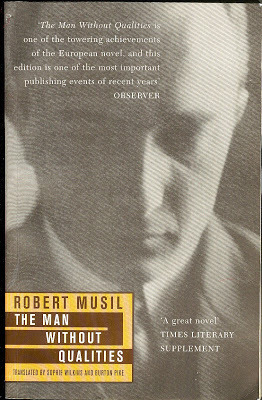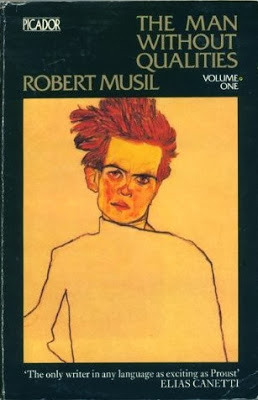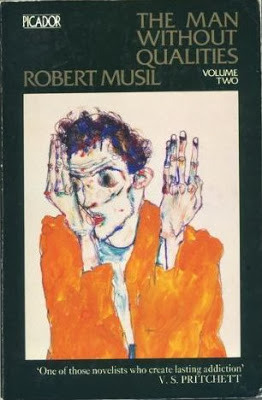Jack Ross's Blog, page 32
July 22, 2014
Phantom Billstickers

Phantom Billstickers: Poetry on Posters Programme (2014)
Sorry for the long delays between posts on this site. I guess it's not much of an excuse, but I have been rather busy setting up a Poetry NZ blog for "views, reviews, interviews, and other news" about the magazine.
In the meantime, though, I did get quite a kick from seeing my very first poetry poster, from the Phantom Billstickers, "New Zealand's largest and finest street poster and street media company."
The plan is that they're going to produce a poster for each of the readers at "Poetry Central," the Auckland Central Library celebration of Poetry Day (which falls on Friday 22nd August - 5.30 for 6 pm - this year), and plaster them up all around the event. The above is my contribution to the festivities.
Here's the list of readers: Michele LeggottMakyla CurtisMurray EdmondYa-Wen HoSelina Tusitala MarshAlice MillerJohn NewtonJack RossRobert Sullivan

Auckland Central Library
Published on July 22, 2014 15:42
May 18, 2014
Why Robert Graves?
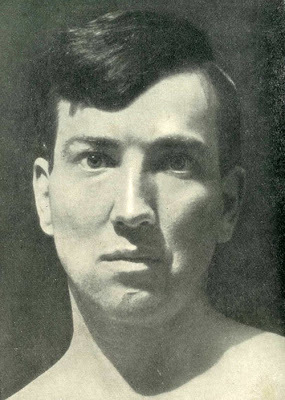
Eric Kennington: Robert Graves (1929)
I suppose that the upcoming anniversary of the outbreak of war in August, 1914 has got me thinking again about the literature of the First World War. Having recently read Harry Rickett's excellent book Strange Meetings: The Lives of the Poets of the Great War (2010), I realised just how little I knew about so many of the writers he mentions. Some, admittedly, sound more interesting as people than poets: Robert Nicholls, for instance. It did get me daydreaming of a systematic re-reading of some of my favourites, though.
Probably first and foremost among these is Robert Graves. Just last year I managed to acquire the missing volumes of his nephew Richard Perceval Graves' rather soupy (but nevertheless indispensable) biographical trilogy about his uncle. I'd read them before, but they did remind just how long and complex - and strange - a time "old Gravy" (to quote Siegfried Sassoon's nickname for him) had of it: all those books, all those projects, all that basking in the sun in the Balearic Islands (or, rather, sitting inside reading and typing in Deyà, Majorca).
In fact it was rereading Sassoon's own (lightly fictionalised) autobiographical trilogy, Memoirs of a Foxhunting Man, Memoirs of an Infantry Officer and Sherston's Progress that got me going again on Graves (whom he calls, in context, "David Cromlech"). They were very different people, and their friendship did not long survive the war - though it was really the advent of Laura Riding, Graves's principal model for the "White Goddess" that clinched it. That, and some rather tactless demands for money on Graves's part ("Why keep a Jewish friend unless you bleed him?" as Sassoon rather chillingly remarked in a verse letter to RG).
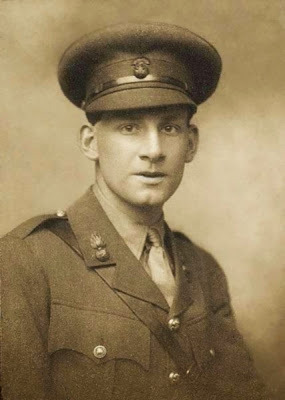
George Charles Bereford: Siegfried Sassoon (1915)
Rather than personalities, then, I thought it might be best to concentrate on Graves's undoubted successes, his unequivocal masterpieces, if you like. In my opinion there are (at least) five of them:
Memoir: Good-bye to All That: An Autobiography (1929)Revised edition (1957)
The concensus of opinion now seems to be that the best version of this "early autobiography" to read is the 1929 one, published shortly before Graves's departure for Majorca with his new muse, Laura Riding. The 1957 revision, which is the one I first read myself (and which is most readily available) tends to soften the abrupt and eccentric typography and sentence structures of the original text, althrough it does expand on certain details (notably Graves's relationship with T. E. Lawrence). The awkward truth is that neither version is entirely satisfactory on its own: you really have to read both to appreciate the full force of Graves's imagination in full cry.
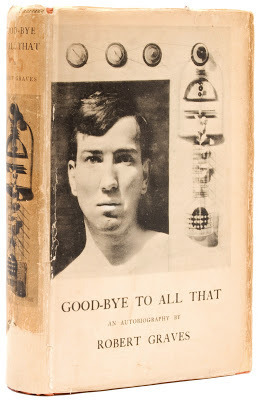
Robert Graves: Good-bye to All That (1929)
Fiction: I, Claudius: From the Autobiography of Tiberius Claudius (1934)Claudius the God and his Wife Messalina (1934)
Ever since this book was dramatised by the BBC in the 1970s, it has needed little introduction (there was an earlier attempt to film it in the 1930s, with Charles Laughton as claudius, but that ended up on the cutting room floor, unfortunately). It remains by far the most convincing and entertaining revisionist history of the early Caesars, despite all the myriad attempts to supplant it since. It's also the most immediately accessible and readable of Graves's historical novels, despite the fascinating material included in many of the others.
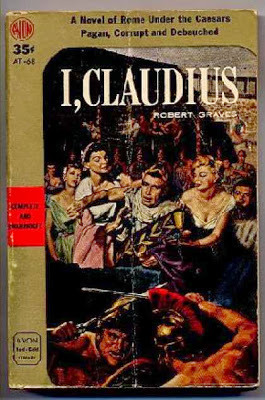
Robert Graves: I, Claudius (1934)
Speculative Non-fiction: The White Goddess: A Historical Grammar of Poetic Myth (1948)Amended and Enlarged Edition (1961)
It's hard to describe this book accurately without making it sound like the work of a raving lunatic. Graves's speculations take him from the stone age to late antiquity, and include "solutions" to any number of unsolveable riddles and conundrums. It has to be experienced to be believed, but there's no doubt that no-one has ever written a more explosive book on the true nature of the poetic imagination.
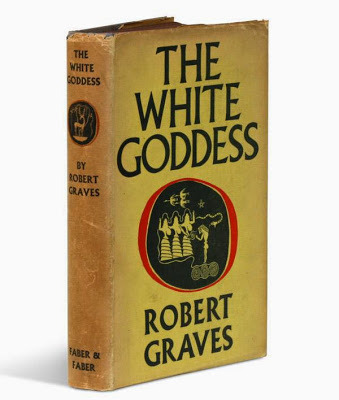
Robert Graves: The White Goddess (1948)
Translation: The Transformations of Lucius, Otherwise Known as The Golden Ass (1950)
It may seem a little surprising to include a mere translation here, but I do feel that this one stands out from Graves's many solid achievements in this genre. There's something about his deadpan delivery which enables Apuleius' masterpiece to shine out, unimpeded by the clumsy literalism which so many of his other modern translators have clung to. It stays in print for a good reason: because people enjoy it more than any of the rival versions.
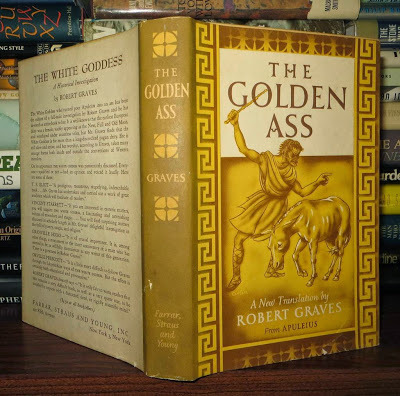
Robert Graves, trans.: The Golden Ass (1950)
Classical Scholarship: The Greek Myths (1955)Revised edition (1960)
The successive editions of this work incorporated more and more of Graves's increasingly out-there conjectures about the ancient Greeks (the contention that "ambrosia" was magic mushrooms, for instance), but for sheer concision and completeness, it's hard to fault this work. It offers multiple versions of most of the stories, together with clear source notes and - admittedly speculative - explanations of some of their stranger features. In other words, it emphasises the dynamic and fluid nature of myth, rather than clinging to a single interpretative paradigm. That's one reason it's still of use 60 years after its first publication.
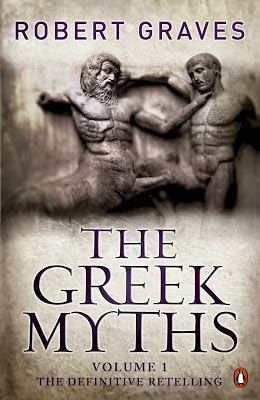
Robert Graves: The Greek Myths (1955)
Some would add to this list his bizarre series of speculations about Christianity, culminating in the massive Nazarene Gospel Restored (1954) - and including along the way such eccentric works as My Head! My Head! Being the History of Elisha and the Shulamite Woman; with the History of Moses as Elisha related it, and her Questions put to him (1925), King Jesus (1946), Adam’s Rib and Other Anomalous Elements in the Hebrew Creation Myth: A New View (1955), Jesus in Rome (1957) and Hebrew Myths: The Book of Genesis (1964).
For me, that's a step too far. But I certainly acknowledge that this was - first to last - one of the subjects which most consistently interested Graves, from the very first poem in his Collected Poems, "In the Wilderness," about Jesus's meeting with the "guileless young scapegoat," to his later works of Biblical reconstruction, many of them written in collaboration with Talmudic scholar Joshua Podro.
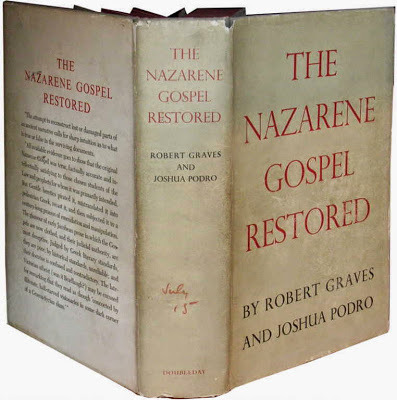
Robert Graves & Joshua Podro: The Nazarene Gospel Restored (1954)
But why no poetry? Graves was, after all, a poet first and foremost. I have to say that my enthusiasm for his poetry has waned over the years, though I still like a lot of the pieces included in his own successively winnowed-down volumes of Collected Poems, culminating in the 1975 volume which was the last he personally oversaw.
This has now been supplanted by the three-volume Carcanet edition of his Complete Poems (also available as a single volume, without the apparatus and textual variants). I suppose there would be an argument for including that, too, among the "indispensible" works of Graves. There's a lot there to take in, though, and certainly a lot that he personally repudiated along the way.
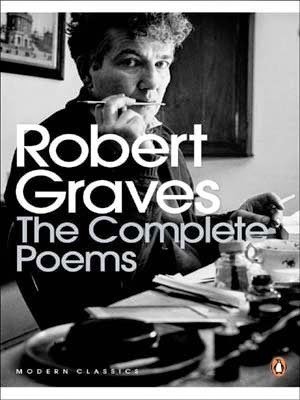
Robert Graves: The Complete Poems (2000)
As a supplement to my usual habit of listing all the books which I, personally, own by Robert Graves (and there are many), I thought it might be best to begin by discussing Manchester poetry publisher Carcanet's fifteen-year Robert Graves project.
Beginning with the three volumes of Complete Poems mentioned above, they've reprinted, in handsome, well-edited new editions, the following texts - often in new, definitive versions. I've put in bold the ones that I myself own - or have on order at present:
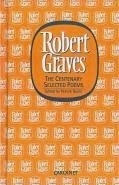
Robert Graves: Selected Poems, ed. Patrick Quinn (1995)
Selected Poems, ed. Patrick Quinn (1995)
Collected Writings on Poetry, ed. Patrick Quinn (1995)
Complete Short Stories, ed. Lucia Graves (1995)
Complete Poems, Volume I, ed. Beryl Graves & Dunstan Ward (1995)
Complete Poems, Volume II, ed. Beryl Graves & Dunstan Ward (1997)
The White Goddess, ed. Grevel Lindop (1997)
I, Claudius & Claudius the God, ed. Patrick Quinn (1998)
The Sergeant Lamb Novels, ed. Patrick Quinn (1999)
Complete Poems, Volume III, ed. Beryl Graves & Dunstan Ward (1999)
Some Speculations on Literature, History and Religion, ed. Patrick Quinn (2000)
Complete Poems in One Volume, ed. Beryl Graves & Dunstan Ward (1999)
Homer's Daughter & The Anger of Achilles, ed. Neil Powell (2001)
Greek Myths, ed. Patrick Quinn (2001)
[with Laura Riding] Essays From 'Epilogue' 1935-1937, ed. Mark Jacobs (2001)
[with Laura Riding] A Survey of Modernist Poetry & A Pamphlet Against Anthologies, ed. Patrick McGuinness and Charles Mundye (2002)
The Story of Marie Powell, Wife to Mr Milton & The Islands of Unwisdom, ed. Simon Brittan (2003)
Antigua, Penny, Puce & They Hanged my Saintly Billy, ed. Ian McCormick (2003)
The Golden Fleece & Seven Days in New Crete, ed. Patrick Quinn (2004)
Count Belisarius & Lawrence and the Arabs, ed. Scott Ashley (2004)
[with Raphael Patai] The Hebrew Myths: The Book of Genesis, ed. Robert A. Davis (2005)
King Jesus & My Head! My Head!, ed. Robert A. Davis (2006)
{with Alan Hodge] The Long Weekend & The Reader over Your Shoulder (2006)
Goodbye to All That and Other Great War Writings, ed. Steven Trout (2007)
Translating Rome: Apuleius' The Golden Ass; Lucan's Pharsalia; Suetonius' The Twelve Caesars, ed. Robert Cummings (2010)
[with Joshua Podro] The Nazarene Gospel Restored, ed. John Presley (2010)
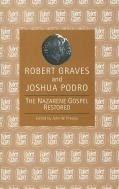
Robert Graves & Joshua Podro: The Nazarene Gospel Restored (1954 / 2010)
It's a terrfiyingly ambitious project. They've republished all 14 of his historical novels; all his short stories; all of his poetry; a substantial selection of his essays, works of non-fiction and translations; as well as the most substantive of his collaborations with Laura Riding.
I'd really like to own the entire set, but one must be sensible - and, after all, I have most of the others in their original editions. The only serious deficiency in my own collection is The Nazarene Gospel Restored. The Carcanet edition of this (with significant revisions and additions) seems to have gone out of print soon after it was published. They do list it as "reprinting" on their website, though, so I have hopes of adding that to my collection soon, too.
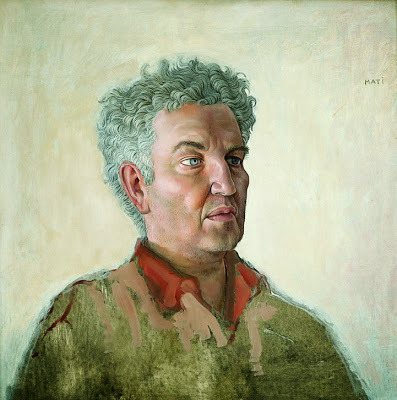
Mati Klarwein: Robert Graves (1957)
Robert Ranke Graves
(1895-1985)
Poetry:
Graves, Robert. Over the Brazier. 1916. Poetry Reprint Series, 1. London: St. James Press / New York: St. Martin’s Press, 1975.
Graves, Robert. Poems 1926 to 1930. London: William Heinemann Ltd., 1931.
Graves, Robert. Collected Poems 1965. London: Cassell & Company Ltd., 1965.
Graves, Robert. Poems 1968-1970. London: Cassell & Company Ltd., 1970.
Graves, Robert. Poems: Abridged for Dolls and Princes. London: Cassell & Company Ltd., 1971.
Graves, Robert. Collected Poems 1975. London: Cassell, 1975.
Graves, Robert. Complete Poems, Volume 1. Ed. Beryl Graves & Dunstan Ward Manchester & Paris: Carcanet & Alyscamp Press, 1995.
Graves, Robert. The Complete Poems in One Volume. Ed. Beryl Graves & Dunstan Ward. 2000. Penguin Classics. Harmondsworth: Penguin, 2003.
I have the two remaining volumes of Complete Poems on order, but haven't received them yet. Volume I is certainly impressively scholarly (if a little overwhelming), though.
Fiction:
[Graves, Robert. My Head! My Head! Being the History of Elisha and the Shulamite Woman; with the History of Moses as Elisha related it, and her Questions put to him. London: Martin Secker, 1925.]
Graves, Robert. I, Claudius: From the Autobiography of Tiberius Claudius. 1934. London: Arthur Barker Limited, 1936.
Graves, Robert. Claudius the God and his Wife Messalina. 1934. London: Methuen & Co. Ltd., 1947.
Graves, Robert. ‘Antigua, Penny, Puce’. 1936. Harmondsworth: Penguin, 1968.
Graves, Robert. Count Belisarius. 1938. Harmondsworth: Penguin, 1954.
Graves, Robert. Sergeant Lamb’s America: A Novel. 1940. Vintage Books. New York: Alfred A. Knopf, Inc. / Random House, Inc., 1962.
Graves, Robert. Proceed, Sergeant Lamb. 1941. London: Methuen & Co. Ltd., 1946.
Graves, Robert. Wife to Mr Milton: The Story of Marie Powell. 1943. Chicago: Academy Chicago Limited, , 1979.
Graves, Robert. The Golden Fleece. 1944. Pocket Library. London: Cassell & Co., Ltd., 1951.
Graves, Robert. The Golden Fleece. 1944. London: Hutchinson & Co (Publishers) Ltd., 1983.
Graves, Robert. King Jesus. London: Cassell & Company Ltd., 1946.
Graves, Robert. King Jesus. 1946. London: Hutchinson & Co. (Publishers) Ltd., 1983.
Graves, Robert. Seven Days in New Crete: A Novel. London: Cassell & Company Limited, 1949.
Graves, Robert. Seven Days in New Crete. 1949. Introduction by Martin Seymour-Smith. Twentieth-Century Classics. Oxford: Oxford University Press, 1983.
Graves, Robert. The Isles of Unwisdom. London: Readers Union / Cassell & Company Ltd., 1952.
Graves, Robert. Homer's Daughter. London: Cassell & Company Ltd., 1955.
Graves, Robert. They Hanged My Saintly Billy. 1957. A Grey Arrow. London: Arrow Books Limited, 1962.
Graves, Robert. ‘Antigua, Penny, Puce’ and They Hanged My Saintly Billy. 1936 & 1957. Ed. Ian McCormick. Robert Graves Programme. Ed. Patrick J. M. Quinn. Manchester: Carcanet Press Limited, 2003.
Graves, Robert. The Big Green Book. Illustrated by Maurice Sendak. 1962. A Young Puffin. Harmondsworth: Penguin, 1978.
Graves, Robert. The Siege and Fall of Troy: Retold for Young People. Illustrated by C. Walter Hodges. London: Cassell & Company Ltd., 1962.
Graves, Robert. Collected Short Stories. 1964. Harmondsworth: Penguin, 1965.
I have the Complete Stories on order, but haven't received it yet. I think there are a few more children's books, and an early novel written in collaboration with Laura Riding - No Decency Left (1932), not to mention his "re-written" version of Dickens, The Real David Copperfield (1933), to collect, but otherwise I think that's all his published writing in this form.
Non-Fiction:
Graves, Robert. English and Scottish Ballads. 1927. Heinemann Educational Books Ltd. 1957. London: Heinemann, 1969.
Graves, Robert. Lars Porsena, Or The Future of Swearing and Improper Language. 1927. London: Martin Brian & O'Keeffe Ltd., 1972.
Graves, Robert. Lawrence and the Arabs. Illustrations ed. Eric Kennington. Maps by Herry Perry. London: Jonathan Cape Ltd., 1927.
Graves, Robert. Good-bye to All That: An Autobiography. 1929. London: Jonathan Cape, 1929.
Graves, Robert. Good-bye to All That. 1929. Rev. ed. 1957. Penguin Modern Classics. Harmondsworth: Penguin, 1973.
Graves, Robert, & Alan Hodge. The Long Weekend: a Social History of Great Britain, 1918-1939. 1940. London: Readers’ Union Limited, 1941.
Graves, Robert, & Alan Hodge. The Reader Over Your Shoulder: A Handbook for Writers of English Prose. London: Jonathan Cape Ltd., 1943.
Graves, Robert. The White Goddess: A Historical Grammar of Poetic Myth. 1948. Amended and Enlarged Edition. 1961. London: Faber, 1977.
Graves, Robert. The Common Asphodel: Essays on Poets and Poetry, 1922-1949. London: Hamish Hamilton, 1949.
Graves, Robert. Occupation: Writer. London: Cassell & Company Ltd., 1951.
Graves, Robert. Adam’s Rib and Other Anomalous Elements in the Hebrew Creation Myth: A New View. With Wood Engravings by James Metcalf. 1955. New York: Thomas Yoseloff, 1958.
Graves, Robert. The Crowning Privilege: Collected Essays on Poetry. 1955. A Pelican Book. Harmondsworth: Penguin, 1959.
Graves, Robert. Greek Myths. 1955. Rev. ed. London: Cassell & Company Ltd., 1958.
Graves, Robert. The Greek Myths. 2 vols. 1955. Rev. ed. 1958. Rev. ed. 1960. Pelican Books. Harmondsworth: Penguin, 1978.
Graves, Robert. The Greek Myths. 2 vols. 1955. Rev. ed. 1958. Rev. ed. 1960. Introduction by Kenneth McLeish. Illustrations by Grahame Baker. 1996. London: The Folio Society, 2000.
Graves, Robert. Steps: Stories; Talks; Essays; Poems; Studies in History. London: Cassell & Company Ltd., 1958.
Graves, Robert, & Raphael Patai. Hebrew Myths: The Book of Genesis. 1964. An Arena book. London: Arrow Books Limited, 1989.
Graves, Robert. The Crane Bag and Other Disputed Subjects. 1969. London: Cassell & Company Ltd., 1970.
Graves, Robert. Difficult Questions, Easy Answers. London: Cassell & Company Ltd., 1972.
Graves, Robert. Some Speculations on Literature, History and Religion. Ed. Patrick Quinn. Robert Graves Programme. Ed. Patrick J. M. Quinn. Manchester: Carcanet Press Limited, 2000.
This is the hardest genre of Graves-iana to collect - he wrote so many books of essays and miscellaneous non-fiction, sometimes with different titles (and even different contents) for the UK and US editions. As you can see, I have been fairly assiduous, but there are still many gaps in my holdings.
Translations:
Apuleius, Lucius. The Transformations of Lucius, Otherwise Known as The Golden Ass. Trans. Robert Graves. Penguin Classics. 1950. Harmondsworth: Penguin, 1950.
Apuleius, Lucius. The Transformations of Lucius, Otherwise Known as The Golden Ass. Trans. Robert Graves. 1950. Rev. Michael Grant. Penguin Classics. Harmondsworth: Penguin, 1990.
Alarcón, Pedro Antonio de. The Infant with the Globe. Trans. Robert Graves. Trianon Press Limited. London: Faber, 1955.
Galvan, Manuel de Jesus. The Cross and the Sword. 1882. Trans. Robert Graves. Foreword by Max Henríquez Ureña. London: Victor Gollancz Ltd., 1956.
Sand, George. Winter in Majorca. 1855. Trans. Robert Graves. With José Quadrado's Refutation of George Sand. Mallorca: Valldemosa Edition, 1956.
Lucan. Pharsalia: Dramatic Incidents of the Civil Wars. Trans. Robert Graves. Penguin Classics. Harmondsworth: Penguin, 1956.
Suetonius Tranquillus, Gaius. The Twelve Caesars. Trans. Robert Graves. 1957. Penguin Classics. Harmondsworth: Penguin, 1962.
Suetonius Tranquillus, Gaius. The Twelve Caesars: An Illustrated Edition. Trans. Robert Graves. 1957. Rev. Michael Grant. Ed. Sabine McCormack. 1979. Harmondsworth: Penguin, 1982.
Graves, Robert, trans. The Anger of Achilles: Homer’s Iliad. London: Cassell, 1960.
Graves, Robert, & Omar Ali-Shah, trans. The Rubaiyyat of Omar Khayaam: A New Translation with Critical Commentaries. 1967. Harmondsworth: Penguin, 1972.
Graves, Robert. The Song of Songs: Text and Commentary. Illustrated by Hans Erni. New York: Clarkson N. Potter, Inc., Publisher, 1973.
The only translation I'm aware of lacking is Georg Schwarz's Almost Forgotten Germany (1936). There may well be others I don't know about, though. There's a good deal of translation in some of the books on mythology.
Edited:
Richards, Frank. Old Soldiers Never Die. 1933. Uckfield, East Sussex: The Naval & Military Press, Ltd., 2009.
Richards, Frank. Old Soldier Sahib. Introduction by Robert Graves. 1936. Uckfield, East Sussex: The Naval & Military Press, Ltd., 2009.
Graves is alleged to have done a good deal of editing work on both of these books of war memoirs by "Frank Richards" (born Francis Philip Woodruff).
Secondary:
Seymour-Smith, Martin. Robert Graves: His Life and Work. 1982. Abacus. London: Sphere Books Ltd., 1983.
Graves, Robert. In Broken Images: Selected Letters 1914-1946. Ed. Paul O'Prey. London: Hutchinson, 1982.
Graves, Robert. Between Moon and Moon: Selected Letters 1946-1972. Ed. Paul O'Prey. London: Hutchinson, 1984.
Graves, Richard Perceval. Robert Graves: The Assault Heroic, 1895-1926. London: George Weidenfeld and Nicolson Limited, 1986.
Graves, Richard Perceval. Robert Graves: The Years with Laura, 1926-1940. Viking. New York: Penguin Books USA Inc., 1990.
Graves, Richard Perceval. Robert Graves and the White Goddess, 1940-1985. 1995. Phoenix Giant. London: Orion Books Ltd., 1998.
Seymour, Miranda. Robert Graves: Life on the Edge. 1995. Doubleday. London: Transworld Publishers Ltd., 1996.
Probably the best of these biographies is Miranda Seymour's - there's no getting over the completeness and detail of Richard Perceval Graves' rather family-centred version of his uncle's life, though. Martin Seymour-Smith's is well written but (I'm told) unreliable on details. Probably the letters give the best sense of the man himself.
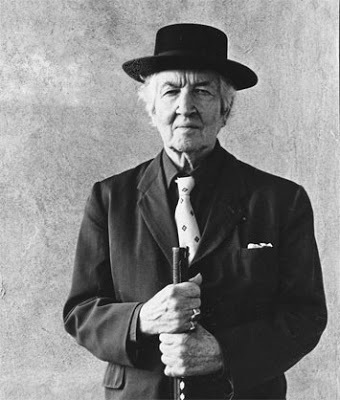
Robert Graves in Krakow (1974)
Published on May 18, 2014 17:01
May 11, 2014
Agnostic vs. Atheist
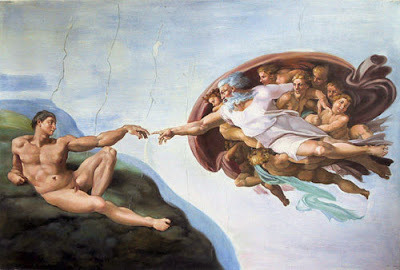
Michelangelo: Creation of Adam (c.1511-12)
There was an embarrassing moment at our house this Christmas when I opened up one of my presents only to find that it was a copy of Richard Dawkins' autobiography. My mother - who is religious - made a few muttered remarks about Dawkins' general arrogance and "refusal to debate," and even my brother - who isn't - started in on poor ol' Rich.
What is it about Richard Dawkins? Why is he such a bugbear? I guess there's a certain intransigeance in his defence of the strict Darwinian party line, but it's interesting that other equally inflexible ideologues don't seem to generate the same amount of heat.
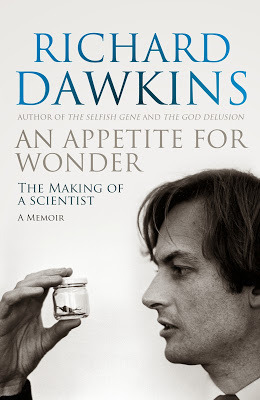
Richard Dawkins: An Appetite for Wonder (2013)
I was reading his book The God Delusion last year - "The statements was interesting, but tough," as Huckleberry Finn remarked of Bunyan's Pilgrim's Progress - when I had a little epiphany (so to speak).
Essentially, I suddenly understood the true meaning of the word "atheist," and the reason why people who label themselves thus are so resistant of the apparently more placatory term "agnostic."
An atheist, I'd always been taught, is someone who asserts the absolute impossibility of the existence of God. Given that providing an absolute proof of the non-existence of anything is a virtually impossible task, Thomas Huxley's compromise term "agnostic": one who simply refuses to claim definitive knowledge on the subject, had always seemed more intellectually defensible to me.
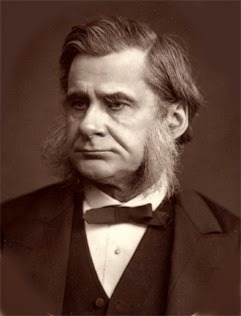
Thomas H. Huxley: aka "Darwin's Bulldog"
Dawkins, however, asks how many people nowadays would claim to be "agnostic" on the subject of the existence of Zeus, or Odin, or Osiris, or any other member of the traditional mythological pantheons? Not many, if any (to paraphrase our local rapper Scribe). In other words, we don't take the question seriously enough to bother with entertaining the notion that Hermes or Aphrodite might actually be hovering about, listening in on our thoughts and conversations.
They could be, mind you. It's ridiculously improbable, but not by any means impossible. So perhaps one should declare agnosticism on the question of the existence of Santa Claus, the Easter Bunny, and Saddam Hussein's Weapons of Mass Destruction also ...
Why don't we? Because (I suspect) in these cases, at least, we don't feel that the burden of proof should lie on the unbelievers. It should lie firmly with the true believers (if there are any). If Odin is real, I'd need to see some proof of it. And it had better be pretty convincing proof.
David Hume, in his Enquiry concerning Human Understanding (1748) reminds us that "A wise man ... proportions his belief to the evidence." This principle has been popularised by Carl Sagan (among others) in the form: "Extraordinary claims require extraordinary evidence." In the absence of that extraordinary evidence, I'm going to go on assuming that there's no Odin. I don't know there isn't - but I see no legitimate reason for postulating the possibility in the absence of really compelling evidence.
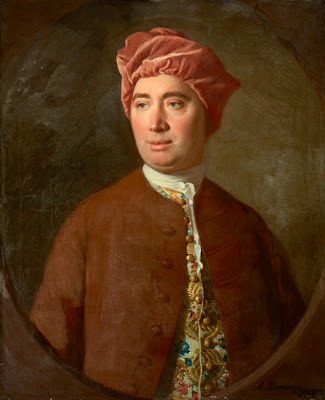
Allan Ramsay: David Hume (1711-1776)
How does this apply to the atheist / agnostic debate? Well, my epiphany (if that's what it was) consisted simply of the recognition that the term "Atheist" should be taken to apply to a default position, rather than being confused with a statement of belief.
I don't know that there's no God. But my default position is that there isn't - since no-one has yet shown me the extraordinary evidence required to substantiate such an extraordinary claim (and not for want of asking, either). Occam's razor states that "It is futile to do with more things that which can be done with fewer": in other words, as a basic postulate of argument, one should always go for the most economical of the various hypotheses available, the one which requires fewest assumptions.
This default position seems to me best labelled "Atheism". Like a Huxleyan Agnostic, I claim no special knowledge, assert no conviction of non-existence: just as none of us bother to with Odin, Thor, Hermes and the rest. They could all be real, but there's no particular reason to suppose so. The real problem with the Huxley position, however, is that it implies an equal probability for the existence or non-existence of God (in whatever form one wants to conceptualise such a teleological being - or "law of the universe", impersonal ethical principle, etc. etc.)
I don't think that it's reasonable to see these positions as equally plausible. Given two models of the universe: one naturalistic, subject to verification by scientific experiment, and deducible from phenomena which do indeed demonstrably surround us; the other dependent on a nebulous Catch-22 notion called "faith," which by its very nature precludes the necessity (or even possibility?) of objective verification, there's really no contest for me.
History, too, is on my side in this, I'm afraid. When one looks at the number of people throughout the millennia who have claimed to have a hotline to some almighty spirit who just happens to be in accord with everything they're planning to do, while being irrevocably opposed to everything their opponents are up to, I would ask simply how many of those people you actually still believe in? The rivalry between the twin tribal deities "God" and "Gott" on the Western Front in the First World War is one classic example, amusingly outlined by Robert Graves in his war memoir Goodbye to All That.
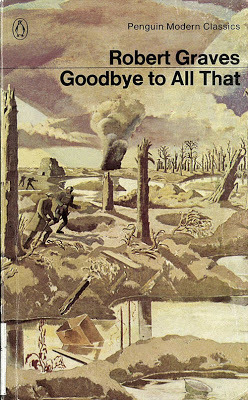
Robert Graves: Goodbye to All That (1929)
I really don't want to be unnecessarily provocative on this subject, obviously a sensitive one. I simply want to explain why atheism is a perfectly sensible intellectual stance, and does not imply that one is automatically an adherent of a complete alternative belief system comparable to a religion. Nor, I would argue, does it involve any assertion that one is in possession of absolute proof of the non-existence of God (or any other supernatural entity, for that matter).
In the absense of convincing proofs, however, one has to position oneself somewhere. Virtually all of us moderns have already decided, willy-nilly, to take up an "atheistic" position on Ishtar, Amun-Re, Tangaroa and all the others. If you think for a moment, I think you'll acknowledge this to be so.
Why, then, should you be indignant if someone takes up the same position vis-à-vis any other belief system? You may well be making an exception in one particular case - and you might even be correct in doing so. But until you can actually prove it, can't we just continue to examine the evidence of the natural world - which should be a complex enough task to satisfy anyone?
Fantasy literature can be fun, and rewarding in many ways, but you don't have to believe in the objective existence of the Kingdom of Westeros to enjoy watching Game of Thrones.
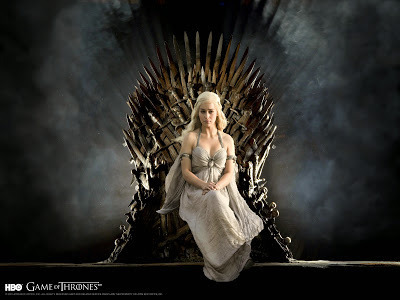
Game of Thrones (2010- )
Published on May 11, 2014 15:03
May 1, 2014
The Ghostseer
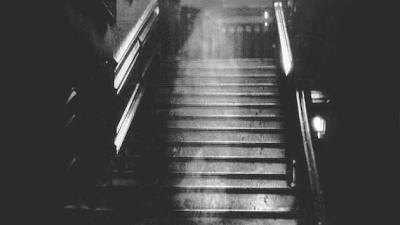
The Brown Lady of Raynham Hall (1936)
I saw a ghost on Monday night. At least I think it was Monday night - the event is getting a little blurry now, a few days later. It might have been Sunday night, the end of mid-semester break, with the alarm clock set for the new working week, but I'm pretty sure that it was Monday.
When I say "saw a ghost," I have to admit that I was in bed at the time, and was definitely in that state of drifting in and out of sleep when most apparitions are seen. It might be better to say "I saw a hypnagogic hallucination of a woman on Monday night" instead, then.
I was lying in bed, as I say, and I saw a woman walk past the door of our room, up the corridor towards the bathroom and the stairs. My impression of her was that she had dark mid-length hair, and was wearing a trench coat or some other kind of dress coat. I think she was wearing a skirt, and had reasonably dressy shoes on too. I only saw her for a moment, though, so I could be wrong about that.
She definitely looked in at me as she passed, and I think she smiled at me - not a particularly warm or reassuring smile, as I examine it now in my mind's eye, but not a clearly threatening one either. A bit of a grimace, really.
I knew at the time that I should get up and go and check if there really was a woman in the house. The bed was very warm, though, and I felt somewhat reluctant to venture out into the cold dark hall. I did hear a few thumps and scrapes later on which (again) should probably have got me out of bed, but didn't. Such things are fairly typical in an old house built in the 1940s, anyway. It wasn't Bronwyn. I could see her lying asleep beside me.
Once before I've had a similar experience, half-waking in a motorcamp unit with the strong impression that there was a strange woman in the room, leaning over the bed. On that occasion, though, there actually was a woman (or so I conjecture). Our neighbours in the motorcamp had been having an uproarious time of it next door, and presumably this was just one of them who'd mistaken the door and walked into the wrong unit. I was wearing my earplugs to shut our the racket they were making, so it would have taken a fair amount of noise to wake me.
On this occasion, though, there's no reason to suppose that the woman was real. The front door was still snibbed with its chain next morning, and the back door was bolted. I don't have any clear guesses who she was, either. She wasn't my sister, who did die in that house: wrong hair colour, and quite a different face.
I record the event for what it's worth, then (not a lot in evidential terms). I've seen hypnagogic phenomena before in that half-asleep / half=waking state: grey cats coming at me across the bed-covers; other animals, friendly and threatening - never a person or even a human face before, though.
I should add that I'd been reading a book about ghosts before going to bed (Roger Clarke's A Natural History of Ghosts: 500 Years of Hunting for Proof), so no doubt I was primed to see something. I have read an awful lot of books on that subject, though, and even slept in allegedly "haunted" housese and rooms, but there's never been so much as the hint of an apparition before - certainly nothing as clear as this.
So is our house haunted? Who can say? There's been no repetition of the sight in the nights since then, and I suspect there won't be - it was an unusually concrete dream manifestation, that's the best I can do. I have no idea why it took that particular form, though.

Woman in trench coat
[She looked something like this: only without the bag and the styly boots: she had straighter hair, too, and her face was turned towards me]
Published on May 01, 2014 13:25
March 12, 2014
Double Whammy
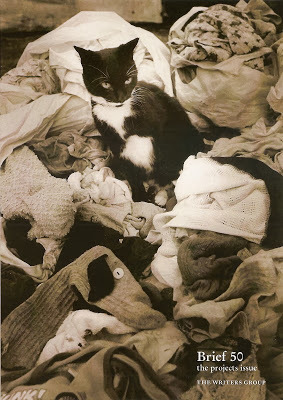
Well, I certainly hope that the subscribers and contributors to brief 50 - the projects issue are pleased with the results of my editing and Brett Cross's stunning text and cover design. More to the point, I hope they're happy to get, as a special bonus with this fiftieth issue of the magazine, a free copy of Leicester Kyle's Millerton Sequences, which has just been published by Atuanui Press:
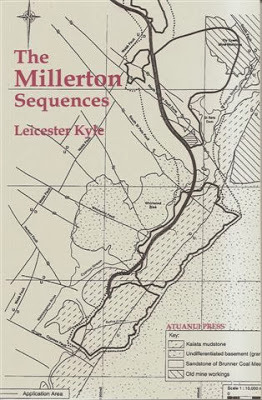
It's been quite a while since I've posted here. Apologies for that: blame it on having to compose a new set of lecture notes for my travel writing paper at Massey, which is proving unexpectedly popular in its new distance form.
That's no excuse, of course. I hope I'll be able to do better now things have settled down a bit.
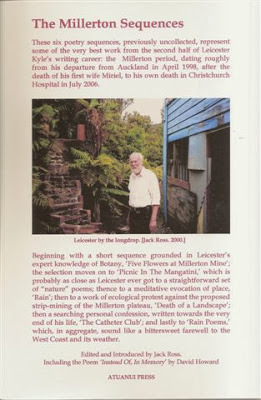
So what exactly is this book, The Millerton Sequences? Well, in a sense it's meant as a culmination of all the work I (and others) have put into the Leicester Kyle website (address below). That site certainly errs on the side of inclusiveness, so I thought it was important to put out a selection of Leicester's shorter poems which would enable readers to appreciate some of the qualities his admirers value most in his work as a whole.
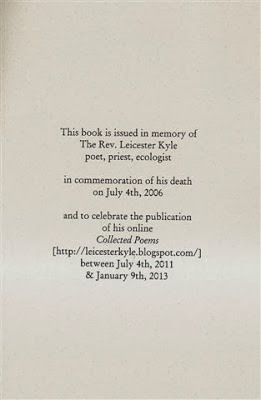
There's an introduction by me, a poem by David Howard - we've tried to make it as attractive a proposition as possible for the casual poetry fan:
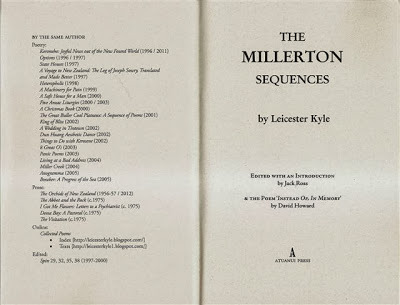
You can find out a lot more about the book here, if you're curious. And, yes, some copies are still available for sale from the Atuanui Press website.
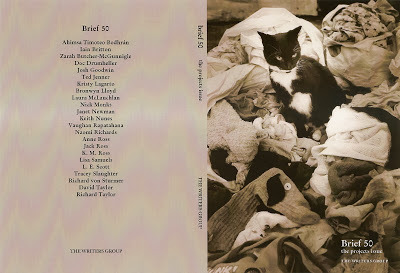
And what of brief? Well, again, you can see a complete list of contents on the brief index site. Here's a list of the authors you can encounter in this special anniversary issue (how many literary magazines - especially experimental ones - actually reach a fiftieth issue?)
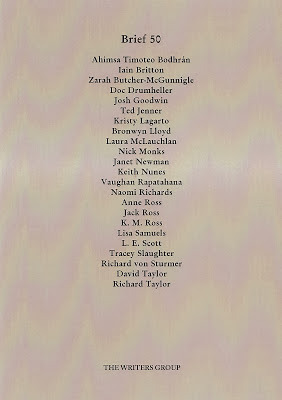
So anyway, as you can see, I've not been entirely idle during this hiatus in Imaginary Museum posts. I can't promise it'll never happen again, but I certainly will try to come up with some fresh new stuff to interest you once I'm over the hump of the next couple of months. Don't write me off just yet ...
Published on March 12, 2014 15:22
January 18, 2014
Changes at Poetry NZ
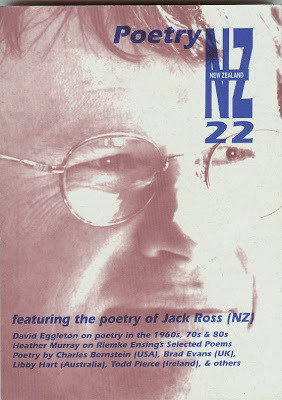
Alistair Paterson, ed.: Poetry NZ 22 (March 2001)
I'm happy to announce that, at a meeting at Massey University's Albany Campus on 26th November 2013, an agreement was reached between the Head of the School of English and Media Studies, A/Prof Joe Grixti, Poetry NZ 's managing editor Alistair Paterson, and production manager John Denny, for the future housing of the magazine by the university.
The new managing editor, in succession to Alistair, will be yours truly. I was featured in issue 22 in 2001, and I guest-edited issue 38 in 2009, which (I hope) qualifies me for such a task - though I don't pretend to claim that I could ever adequately fill Alistair's shoes: he's certainly a hard act to follow.
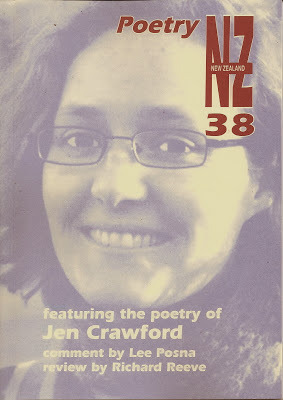
Jack Ross, ed.: Poetry NZ 38 (March 2009)
But what precisely is Poetry NZ ? New Zealand's most celebrated (as well as longest lived) poetry journal has been appearing twice a year since the end of the 80s, when it was started by Oz Kraus, initially with a series of guest editors, but then - from issue 8 onwards - under the editorship of distinguished poet, anthologist, fiction-writer and critic Alistair Paterson.
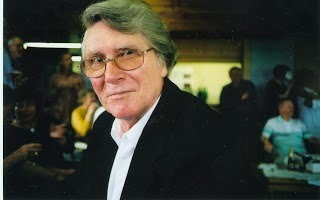
Jan Kemp: Alistair Paterson
In another, truer sense, though, one could argue that the magazine actually started in 1951, when Louis Johnson began publishing his annual New Zealand Poetry Yearbook. That would make it the country's second-oldest surviving literary journal, after Landfall, founded by Charles Brasch in 1947. Johnson's series stopped in 1964, but a bi-annual version of the (re-christened) Poetry New Zealand was revived by Frank McKay in the 1970s and 80s and ran to six issues, each helmed by a different guest editor.
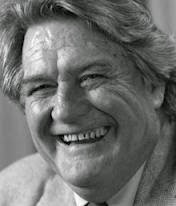
Louis Johnson (1924-1988)
Poetry NZ, in its present form, has now reached issue 47, with a 48th (to be guest-edited by Nicholas Reid) promised for next month. Longtime publisher John Denny of Puriri Press no longer feels able to undertake the myriad duties associated with the production and distribution of the magazine, however, so it seemed like a good moment to re-examine Poetry NZ's future as one of New Zealand's very few journals dedicated entirely to poetry and poetics.
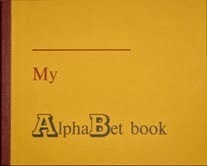
Alphabet Book (Puriri Press)
I will, fortunately, be assisted in my task by an advisory board including academic and editor Dr Thom Conroy; poet and academic Dr Jen Crawford; publisher and printer John Denny; poet and academic Dr Ingrid Horrocks; poet and 2013 Burns Fellow David Howard; poet and editor Alistair Paterson; poet and academic Dr Tracey Slaughter; and poet and academic A/Prof Bryan Walpert.
From issue 49 onwards, our intention is to revert to Louis Johnson's original concept of an annual poetry yearbook, approximately twice the size of the present 112-page issues, but retaining the magazine's essential characteristics, such as the featured poet, the reviews section, at least one substantial essay per issue, and - of course - a substantial selection from the poetry submitted to us by local and international authors.
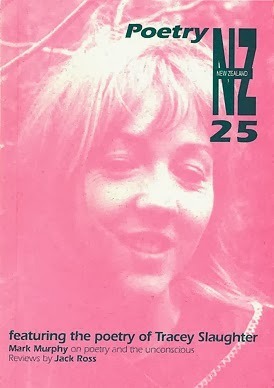
Alistair Paterson, ed.: Poetry NZ 25 (September 2002)
I think that all three of us, Alistair, John and myself, feel that it would be a tragedy for New Zealand poetry if this journal were to cease to appear. Where else can such a substantial cross-section of our poets rub shoulders with writers from all over the world? Where else can we debate the important question of what (if anything) defines a national poetry (or poetics)?
Hopefully having a new institutional home will enable Poetry NZ to continue its already sixty-year-old engagement with such questions in the confidence that it will never become an in-house university publication. Like Landfall, so ably supported by the University of Otago, Poetry NZ will retain its proud independence, but also benefit from the resources of one of New Zealand's largest tertiary institutions (this year celebrating its 21st birthday here on our Auckland campus) ...

Massey's Albany Campus
Existing subscribers will be sent a copy of the enlarged issue no. 49 at no additional cost. Thereafter, though, new subscription arrangements will have to be made. Full details will be published in issue 48, and thereafter made public on the Poetry NZ website.
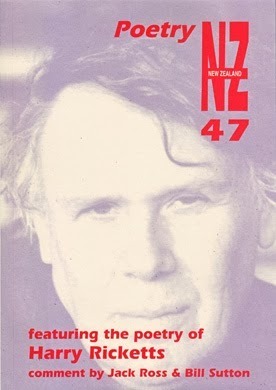
Alistair Paterson, ed.: Poetry NZ 47 (September 2013)
Published on January 18, 2014 14:28
December 21, 2013
The True Story of the Novel (6): The Chinese Novel
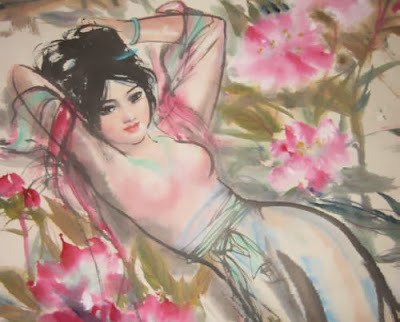
Yao Yuxin: Hsiang-yun among the flowers (1978)
[from Cao Xueqin: Hung-lou Meng, chapter 63]
They went out to look, and sure enough found Hsiang-yun lying on a stone bench in a quiet spot behind an artificial mountain. She was sound asleep and covered with peony petals, which had floated over from all sides to scatter, red and fragrant, over her face and clothes. Her fan, dropped to the ground, was half-buried in fallen blossoms, too, while bees and butterflies were buzzing and flirting around her. And she had wrapped up some peony petals in her handkerchief to serve as a pillow. They all thought she looked both sweet and comical..."
– Tsao Hsueh-chin, A Dream of Red Mansions, trans. Yang Hsien Yi & Gladys Yang (1978): vol. II, p. 364.
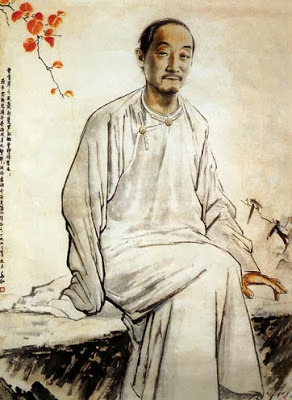
Cao Xueqin
I've already had a fair amount to say on this subject at various times. My essay "In Love with the Chinese Novel: A Voyage around the Hung Lou Meng" appeared in brief 37 (2009): 10-28 (after being long-listed for the Landfall Essay Prize). I also put up a kind of bibliographical post with illustrations of classic Chinese novels here on the Imaginary Museum at roughly the same time.
If it does interest you, I recommend that you check out one or both of these pieces. There doesn't seem much point in repeating here what I've already written there. The topic is, however, a vast one, so I'm certainly not afraid of running out of things to talk about.
To summarise briefly, traditional Chinese critics have identified a canon of four - and only four - Great Classical Novels:
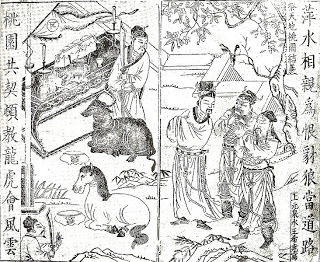
The Three Kingdoms: The Peach Garden Oath (1591)
Luo Guanzhong: Sānguó Yǎnyì [The Three Kingdoms] (c.1400)
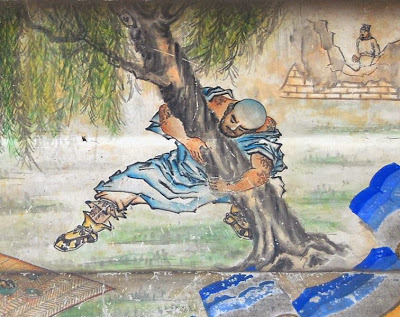
The Water Margin: Lu Zhishen uproots a tree (19th century)
Shi Nai'an: Shuǐhǔ Zhuàn [The Water Margin] (late 14th century)
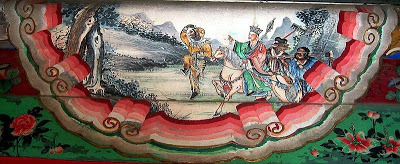
Journey to the West: The Four Pilgrims (Summer Palace, Beijing)
Wu Cheng'en: Xī Yóu Jì [Journey to the West] (1592)
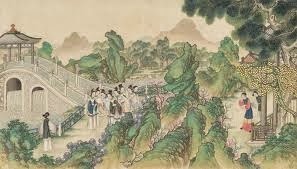
Dream of the Red Chamber: The Crab-Flower Club (19th century)
Cao Xue Qin: Hóng Lóu Mèng [The Red Chamber Dream] (late 18th century)
Here are some of the principal English translations of each novel (all are fortunately now available in complete, scholarly versions):
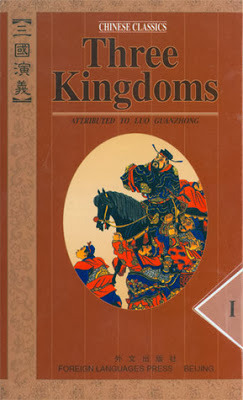
Moss Roberts, trans.: The Three Kingdoms (1994)
The Three Kingdoms
Lo Kuan-Chung. San Kuo, or Romance of the Three Kingdoms. Trans. C. H. Brewitt-Taylor. 2 vols. Shanghai: Kelly & Walsh, 1925.
Luo Guanzhong. Three Kingdoms: A Historical Novel. Trans. Moss Roberts. Foreword by John S. Service. 1994. 3 vols. Beijing: Foreign Languages Press / Berkeley: University of California Press, 1997.
Luo Guanzhong. Three Kingdoms. Trans. Moss Roberts. Foreword by John S. Service. 1994. 4 vols. Beijing: Foreign Languages Press, 2001.
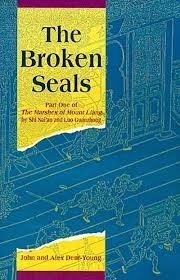
John & Alex Dent-Young, trans.: The Marshes of Mount Liang (1994-2002)
The Water Margin
Buck, Pearl, trans. All Men are Brothers [Shui Hu Chuan]. 2 vols. New York: The John Day Company, 1933.
Shih Nai-an. Water Margin. Trans. J. H. Jackson. 2 vols. Hong Kong: The Commercial Press, 1963.
Weir, David. The Water Margin. London: Weidenfeld & Nicolson, 1978. [based on the BBC TV series]
Shi Nai’an & Luo Guanzhong. Outlaws of the Marsh. Trans. Sidney Shapiro. 3 vols. Beijing: Foreign Languages Press, 1980.
Shi Nai’an & Luo Guanzhong. The Marshes of Mount Liang. Trans. John & Alex Dent-Young. 5 vols. Hong Kong: Chinese University Press, 1994-2002.
Vol. 1: The Broken Seals. 1994.Vol. 2: The Tiger Killers. 1997.Vol. 3: The Gathering Company. 2001.Vol. 4: Iron Ox. 2002.Vol. 5: The Scattered Flock. 2002.
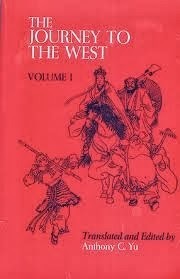
Anthony C. Yu, trans.: The Journey to the West (1977-83)
Journey to the West
Wu Ch’êng-Ên. Monkey. Trans. Arthur Waley. 1942. Penguin Classics. Harmondsworth: Penguin, 1973.
Low, C. C. & Associates, trans. Pictorial Stories of Chinese Classics: The Adventures of the Monkey God. 1975. 4 vols. Singapore: Canfonian Pte Ltd., 1989.
The Journey to the West. Trans. Anthony C. Yu. 4 vols. 1977-1983. Chicago: University of Chicago Press, 1980, 1982, 1980, 1984.
Wu Cheng’en. Journey to the West. Trans. W. J. F. Jenner. 1982. 3 vols. Beijing: Foreign Languages Press, 1990.
Tung Yueh. Hsi-yu pu. Tower of Myriad Mirrors: A Supplement to Journey to the West. Trans. Shuen-fu Lin & Larry J. Schultz. Berkeley, CA: Asian Humanities Press, 1978.
Pisu, Silverio. The Ape. Illustrated by Milo Manara. New York: Catalan Communications, 1986.
Monkey [“Saiyūki”]: Season One: Episodes 1-13. Japan: Nippon TV, 1978.
Monkey [“Saiyūki”]: Season One: Episodes 14-26. Japan: Nippon TV, 1978.
Monkey [“Saiyūki”]: Season Two: Episodes 27-39. Japan: Nippon TV, 1979.
Monkey [“Saiyūki”]: Season Two: Episodes 40-52. Japan: Nippon TV, 1980.
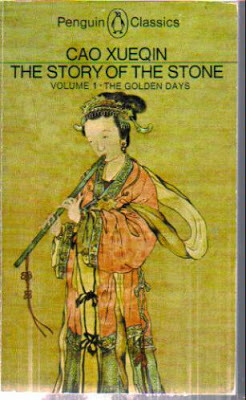
David Hawkes, trans.: The Story of the Stone (1978-86)
The Red Chamber Dream
Tsao Hsueh-Chin. Dream of the Red Chamber. Trans. Chi-chen Wang. 1929. Preface by Mark van Doren. London: Vision Press, 1959.
Kuhn, Franz, ed. Hung Lou Meng: The Dream of the Red Chamber – A Chinese Novel of the Early Ching Period. Trans. Isabel and Florence McHugh. 1958. The Universal Library. New York: Grosset & Dunlop, 1968.
Cao Xueqin. The Story of the Stone: A Chinese Novel by Cao Xueqin in Five Volumes. Trans. David Hawkes. Penguin Classics. Harmondsworth: Penguin, 1973-80.Vol. 1: The Golden Days. 1973.Vol. 2: The Crab-Flower Club. 1977.Vol. 3: The Warning Voice. 1980.
Cao Xueqin. The Story of the Stone (Also Known as The Dream of the Red Chamber): A Chinese Novel by Cao Xueqin in Five Volumes, edited by Gao E. Trans. John Minford. Penguin Classics. Harmondsworth: Penguin, 1982-86.Vol. 4: The Debt of Tears. 1982.Vol. 5: The Dreamer Wakes. 1986.
Tsao Hsueh-Chin & Kao Ngo. A Dream of Red Mansions. Trans. Yang Hsien-Yi & Gladys Yang. 3 vols. Peking: Foreign Languages Press, 1978.
Wu Shih-Ch’Ang. On The Red Chamber Dream: A Critical Study of Two Annotated Manuscripts of the XVIIIth Century. Oxford: Clarendon Press, 1961.
I suppose the first thing to say about these novels is that all they're very long; often available in a variety of versions, sometimes with different numbers of chapters; and that each of these chapters is carefully constructed, and generally introduced by a poetic couplet summarizing its contents.
Abridged or "adapted" versions can give you some of the flavour of the originals, but unfortunately they're bound by their very nature to miss out certain of the vital characteristics of these very particular masterpieces of the novelist's art: above all, the immense scope and inclusiveness of all four of these works.
Though they clearly build upon one another, each of the four has an atmosphere and style all its own:
The Three Kingdoms is a kind of Chinese Iliad, an immense chronicle of war and intrigue spanning decades and vast terrains: a profoundly serious meditation on war and peace and statecraft.
The Water Margin is equally complex, but far more popular and vernacular in tone. It chronicles the adventures of a group of Robin Hood-like outlaws, and is episodic in structure: serious and humorous by turns.
The Journey to the West continues this emphasis on popular culture: in this case myths and folktales, but combines them with a wise, witty, and deeply disenchanted vision of the doings of all the creatures in Earth and Heaven. Wu Cheng’en's novel is, essentially, a satire on conventional religion, but one can't help feeling that the author remains agnostic about the true nature of the universe lying behind this absurd veil of appearances ...
The Red Chamber Dream, finally, is a family chronicle - deeply autobiographical, we are assured, but transformed into a tapestry of poetry, philosophy and eroticism which rivals in intensity anything in Proust or Lady Murasaki. It's probably the most immediately approachable of these great novels, though the frustratingly fragmentary nature of the text means that only the first two thirds of the story seems to reflect accurately its author's original artistic intentions.
What else can one say? There they are. Read them. They're certainly as essential to any true understanding of the possibilities of the novel form as Tolstoy or Flaubert (not to mention Kafka or Joyce).
Once you have read them, though, a number of questions will no doubt arise for you. Why did only these four make the cut? What are all the other Classical Chinese novels like? Are they so inferior to these ones? How reliable is this particular piece of canon-making? Is there really a complete critical concensus about it?
Well, luckily the profusion of new translations of these and other Chinese novels in the second half of the twentieth century was accompanied with some marvellous works of literary analysis and commentary. The place to start remains C. T. Hsia's venerable The Classic Chinese Novel: A Critical Introduction (1968), a work which is unlikely to be superseded anytime soon (despite certain blindspots in his judgements of the individual novels).
Hsia enlarged the canon of "classic novels" to six, including the vast and sexually explicit Jīn Píng Méi [The Golden Lotus] (1618), as well as Wu Jingzi's satire on Confucian bureaucracy Rúlínwàishǐ [The Scholars] (1750). Both are now available in reliable contemporary English translations, luckily (though David Tod Roy's magisterial five-volume version of the Chin P’ing Mei was only completed this year - a couple of months ago, in fact):
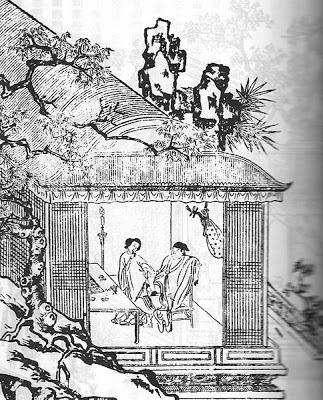
The Golden Lotus: Hsi-men Ching with Golden Lotus (Ming dynasty)
The Golden Lotus
Egerton, Clement, trans. The Golden Lotus: A Translation, from the Chinese Original, of the Novel Chin P’ing Mei. 1939. 4 vols. London: Routledge & Kegan Paul, 1972.
'Lanling Xiiaoxiaosheng'. The Golden Lotus: Jin Ping Mei. Trans. Clement Egerton & Shu Qingchun (Lao She). 1939. Rev. ed. 1972. Introduction by Robert Hegel. 2 vols. Tokyo / Rutland, Vermont / Singapore: Tuttle Publishing, 2011.
Kuhn, Franz, ed. Chin P’ing Mei: The Adventurous History of Hsi Men and his Six Wives. Trans. Bernard Miall. Introduction by Arthur Waley. 1939. London: John Lane The Bodley Head, 1952.
Kuhn, Franz, ed. Ko Lien Hua Ying: Flower Shadows behind the Curtain: A Sequel to Chin P’ing Mei. Trans. Vladimir Kean. London: The Bodley Head, 1959.
Jin Ping Mei: Fleur en Fiole d’Or. 2 vols. Trans. André Lévy. 1985. Collection Folio 3997-8. Paris: Gallimard, 2004.
Magnus. Les 110 pillules, d’après Jin Ping Mei. Trans. Luca Staletti. 1986. Paris: l’Echo des Savanes / Albin Michel, 1991.
Roy, David Tod, trans. The Plum in the Golden Vase or, Chin P’ing Mei. 5 vols. Princeton Library of Asian Translations. Princeton & Oxford: Princeton University Press, 1993-2013.Vol. 1: The Gathering. 1993.Vol. 2: The Rivals. 2001.Vol. 3: The Aphrodisiac. 2006.Vol. 4: The Climax. 2011.Vol. 5: The Dissolution. 2013.
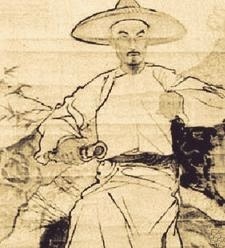
Wu Jingzi (1701-1754)
The Scholars
Wu Ching-Tzu. The Scholars. Trans. Yang Hsien-Yi & Gladys Yang. 1957. Peking: Foreign Languages Press, 1973.
These suggested additions to the list have probably attracted almost as many English-language readers as the other four, given the immense popularity of Hsia's book. And, indeed, the first of them is unquestionably a masterpiece: one of the great novels of world literature. As for the second, its disjointed structure and the very targetted nature of its satire make it a little difficult for a non-Chinese speaking reader to judge. It's certainly not lacking in appeal, though:
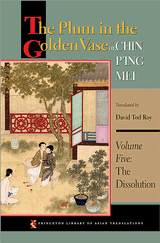
David Tod Roy, trans.: The Plum in the Golden Vase (1993-2013)
The Plum in the Golden Vase is probably the most erotically explicit of all great world novels. Its most recent translator, David Tod Roy, argues persuasively that this is part of the author's complex plan to show the necessary consequences of official corruption in his own day - for Hsi-Men Ching, the protagonist, read the Emperor, and so on down the chain. There's certainly little of the hedonistic romp about it - though some of the earlier, more selective translations did try to stress some of the more playful aspects of the action, trying to imply that this framework of morality was simply a kind of necessary smoke-screen. At least we're finally in a position to consider this question in detail, thanks to Roy's immense and painstaking work of translation and commentary ...
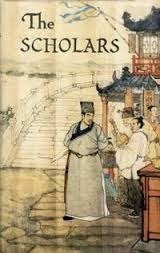
Yang Hsien-Yi & Gladys Yang, trans.: The Scholars (1957)
The Scholars is the least immediately impressive of these classic Chinese novels, but it's certainly readable enough, and one can see a kind of Balzacian intelligence behind it, alert to the untapped possibilities of the novel form for social and intellectual commentary.
It's probably too early to judge whether English-speaking readers are now in a position to appreciate properly the range and scope of the traditional Chinese novel. Certainly Lu Hsun's Brief History of Chinese Fiction (1923-24) lists large numbers of works which are still completely unavailable in translation. Of those that are extant, The 16th-century Creation of the Gods has little beyond the excitement of incident to add to the technical innovations of the "big five" (the four + Chin P'ing Mei). Li Yu's Carnal Prayer Mat is far more witty and entertaining, like a kind of Chinese Fanny Hill, but probably not in itself a "great work" (whatever that means).
The one that really sounds interesting is Li Ju-Chen's Flowers in the Mirror (1828), unfortunately still available only in an abridged and (we're told) inadequate English translation. It is - apparently - a kind of Chinese Alice in Wonderland, with certain aspects of the Pilgrim's Progress mixed in. But since a large part of its appeal comes from the learned game-playing of its author's prose-style, it seems quite likely that it will remain untranslatable for the foreseeable future.
I've compiled a list here of some other striking works of Chinese fiction, short and long. I wish I myself owned more of the excellent critical works which have come out on the subject since C. T. Hsia's, but they tend to be very expensive to buy, and to go out of print pretty quickly: the major ones appear to be Andrew H. Plaks' Four Masterworks of the Ming Novel (1987), David L. Rolston's Traditional Chinese Fiction and Fiction Commentary: Reading and Writing Between the Lines (1997), as well as the same author's earlier collection of edited essays How to Read the Chinese Novel (1990). The only other considerable work on the subject I have a copy of is Robert E. Hegel's excellent (though very specific) The Novel in Seventeenth-Century China (1981).

Jin Ping Mei
Miscellaneous Chinese fiction:
Creation of the Gods [Fêng-shên yen-i] – 16th centuryThe Carnal Prayer Mat [Jou Pu Tuan] – 1657Flowers in the Mirror [Ching hua yuan] – 1828Feng Menglong (1574-1645)Lu Xun (1881-1936)Pu Songling (1640-1715)Robert van Gulik (1910-1967)Anthologies & Secondary Literature
Creation of the Gods [Fêng-shên yen-i] – 16th century
Low, C. C. & Associates, trans. Pictorial Stories of Chinese Classics: Canonization of Deities. 3 vols. Singapore: Canfonian Pte Ltd., 1989.
Gu Zhizhong, trans. Creation of the Gods. 2 vols. 1992. Beijing: New World Press, 1996.
The Carnal Prayer Mat [Jou Pu Tuan] – 1657
Li Yu. Jou Pu Tuan: The Before Midnight Scholar, or The Prayer-mat of Flesh. Ed. Franz Kuhn. 1959. Trans. Richard Martin. 1963. London: Corgi Books, 1974.
Li Yu. The Carnal Prayer Mat. Wordsworth Erotic Classics: Ware, Hertfordshire: Wordsworth Editions, 1995.
Li Yu. The Carnal Prayer Mat. Trans. Patrick Hanan. 1990. Honolulu: University of Hawaí’i Press, 1996.
Li Yu. A Tower for the Summer Heat. Trans. Patrick Hanan. 1992. New York: Columbia University Press, 1998.
Flowers in the Mirror [Ching hua yuan] – 1828
Li Ju-Chen. Flowers in the Mirror. Trans. Lin Tai-Yi. London: Peter Owen, 1965.
Yang Xianyi & Gladys Yang, trans. Excerpts from Three Classical Chinese Novels: The Three Kingdoms, Pilgrimage to the West & Flowers in the Mirror. Beijing: Panda Books, 1981.
Feng Menglong (1574-1645)
Feng Menglong. Stories Old and New: A Ming Dynasty Collection. 1620. Trans. Shuhui Yang and Yunqin Yang. Seattle & London: Washington University Press, 2000.
Zhou Shuren ['Lu Xun' / 'Lu Hsun'] (1881-1936)
Lu Hsun. Selected Stories of Lu Hsun. Trans. Yang Hsien-Yi & Gladys Yang. 1960. Peking: Foreign Languages Press, 1978.
Lu Hsun. Old Tales Retold. Trans. Yang Hsien-Yi & Gladys Yang. 1961. Peking: Foreign Languages Press, 1972.
Lu Hsun. Wild Grass. 1974. Peking: Foreign Languages Press, 1980.
Lu Hsun. Dawn Blossoms Plucked at Dusk. Trans. Yang Hsien-Yi & Gladys Yang. Peking: Foreign Languages Press, 1976.
Lu Xun. Diary of a Madman and Other Stories. Trans. William A. Lyell. Honolulu: University of Hawaii Press, 1990.
Lu Xun. The Real Story of Ah-Q and Other Tales of China: The Complete Fiction of Lu Xun. Trans. Julia Lovell. Afterword by Yiyun Li. Penguin Classics. London: Penguin, 2009.
Lu Hsun. A Brief History of Chinese Fiction. 1923-24. Trans. Yang Hsien-Yi & Gladys Yang. 1959. Peking: Foreign Languages Press, 1982.
Pu Songling / P'u Sung-ling (1640-1715)
P’u Sung-ling. Strange Stories from a Chinese Studio. Trans. Herbert A. Giles. 1916. Honolulu, Hawai’i: University Press of the Pacific, 2003.
Pu Songling. Strange Tales of Liaozhai. Trans. Lu Yunzhong, Yang Liyi, Yang Zhihong, & Chen Tifang. Illustrated by Tao Xuehua. Hong Kong: The Commercial Press, Ltd., 1982.
Pu Songling. Strange Tales from a Chinese Studio. Trans. John Minford. Penguin Classics. Harmondsworth: Penguin, 2006.
Robert Hans van Gulik (1910-1967)
Van Gulik, Robert, trans. Celebrated Cases of Judge Dee (Dee Goong An): An Authentic Eighteenth-Century Detective Novel. 1949. New York: Dover, 1976.
Van Gulik, Robert. The Haunted Monastery & The Chinese Maze Murders: Two Chinese Detective Novels. 1961 & 1957. New York: Dover, 1977.
Anthologies & Secondary Literature
Hegel, Robert E. The Novel in Seventeenth-Century China. New York: Columbia University Press, 1981.
Hsia, C. T. The Classic Chinese Novel: A Critical Introduction. 1968. Bloomington: Indiana University Press, 1980.
Lévy, André, trans. Le Sublime Discours de la fille candide : Manuel d’érotologie chinoise. 2000. Picquier Poche 224. Paris: Philippe Picquier, 2004.
Ma, Y. W. & Joseph M. Lau, eds. Traditional Chinese Stories: Themes and Variations. New York: Columbia University Press, 1978.
Korean:
Kim Man-Choong. The Cloud Dream of the Nine: A Korean Novel – A Story of the Times of the Tangs of China about 840 A.D. Trans. James S. Gale. London: Daniel O’Connor, 1922.
Tibetan:
Tshe ring dbang rgyal. The Tale of the Incomparable Prince. 1727. Trans. Beth Newman. The Library of Tibet. New York: HarperPerennial, 1997.
The last two listed there, from (respectively) ancient Korea and Tibet develop a number of themes from such Buddhist-inspired works as The Journey to the West, but with some additional flavour from their own indigenous traditions.
I should also explain the (apparent) anomaly of listing the sinologist Robert van Gulik among the other authors above. Van GHulik first published a translation of a "genuine eighteenth-century" Chinese detective novel, Celebrated Cases of Judge Dee, in 1949. He proceeded to follow this up with his own original series of crime novels starring the same character, which proved quite popular. It's certainly an unusual (possibly unique) example of direct influence between the Chinese and Western fictional traditions, even though the results read (to me, at any rate) a little on the wooden side.
I guess I began this post with a quote from the Hung Lou Meng to try and give you something of the half-realistic, half-idealised atmosphere of that particular novel. I'll close, instead, with a famous scene from The Three Kingdoms where the warlord Cao Cao reveals his true nature:
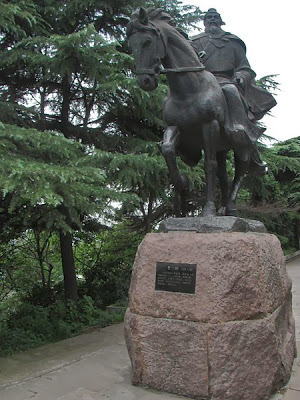
Statue of Cao Cao
During his stay in Lü Boshe's house, Cao Cao overheard the sharpening of knives and a conversation among Lü's servants about whether to "kill or to tie up first", and he suspected that Lü was pretending to be hospitable towards him while actually plotting to harm him. He and Chen Gong dashed out and indiscriminately killed everyone in Lü Boshe's household. Later, they discovered that the servants were actually talking about slaughtering a pig for the feast and that they had killed innocent people. It was too late for regrets, so Cao Cao and Chen Gong immediately packed their belongings and left the house. Along the way, they met Lü Boshe, who was returning from his errand. When Lü Boshe asked them to stay with him, Cao Cao asked, "Who's that behind you?" When Lü Boshe turned around, Cao Cao stabbed him from behind and killed him. Chen Gong was shocked and he questioned Cao Cao, "Just now, you made a genuine mistake when you killed those people. But what about now?" Cao Cao replied, "If Lü Boshe goes home and sees his family members all dead, do you think he'll let us off? If he brings soldiers to pursue us, we'll be in deep trouble." Chen Gong said, "It's a grave sin to kill someone with the intention of doing so." Cao Cao remarked, "I'd rather do wrong to the world than allow the world to do wrong to me." Chen Gong did not respond and he left Cao Cao that night.
That final comment of Cao Cao's:
寧我負人,毋人負我!
nìng wǒ fù rén, wú rén fù wǒ!
"I'd rather do wrong to others than allow them to do wrong to me!"
has become proverbial. In Luo Guanzhong's novel, however, the original wording, used by the historical Cao Cao in 189 CE, has been subtly altered to read:
寧教我負天下人,休教天下人負我
"I'd rather do wrong to the world than allow the world to do wrong to me."
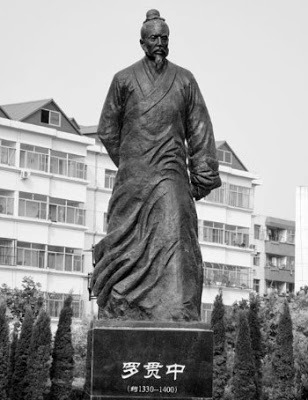
Statue of Luo Guanzhong
Chinese critic Yi Zhongtian claims, in a 2006 essay on the Three Kingdoms, that Luo "deliberately changed the words in the quote to reflect that Cao Cao had no sense of remorse because 'world' [lit. "people under Heaven"] carries greater weight than 'others' [lit. "people"], so as to enhance Cao's image as a villain in his novel."
Whether that's true or not, it gives us a vivid sense of the delicate balance between historical truth and fictional interpretation Lou tries to maintain throughout this most revered of the classical Chinese novels.
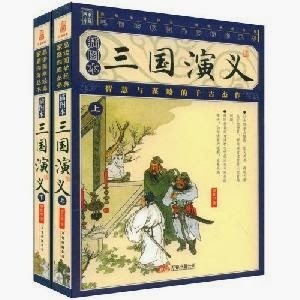
Romance of the Three Kingdoms
Published on December 21, 2013 13:09
December 17, 2013
The True Story of the Novel (5): The Sagas of Icelanders
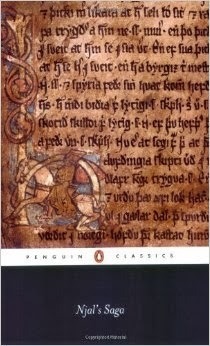
Robert Cook, trans.: Njal's Saga (2001)
It's hard to know quite where to begin with a discussion of the Icelandic sagas. Why do people go on about them so much? Why are they so important? Are they so important? What makes them so different from other examples of medieval prose literature?
I suppose, from my own point of view, the main reason they need to be talked about here is because they so perfectly exemplify the aetiology of prose fiction I'm proposing: that it represents a fairly straightforward evolution from other pre-existing narrative genres.
Gabriel Turville-Peter's classic book The Origins of Icelandic Literature (1953) gives a very clear account of how the early chronicles of the settlement of Iceland, the Landnámabók (c.11th-13th century) and the genealogical treatise Íslendingabók by Ari Þorgilsson (1067–1148) - also known as "Ari the Wise" - provided much of the raw material on which the sagas are based. They were also much influenced by Saint's Lives, by the historical materials about the Norwegian kings also available to the early settlers, as well as the large body of summaries of Greek, Roman and Old Germanic literature compiled by the indefatigable early Icelandic scribes.
The sheer isolation of Icelandic society means that one can study the effects of all these blended materials as a kind of scientific case study in literary development. It's not that anyone could ever neatly explain away so unusual a phenomenon as the Icelandic family sagas (or Íslendingasögur, "Sagas of Icelanders") - with their unique blend of oral history and poetic creativity - but it is interesting to observe the parallels with (say) the origins of the Japanese monogatari or the Arthurian prose vulgate tradition.
In essence, then, the medieval Icelanders tried to summarise and copy all the literary materials available to them - from Homer's Iliad to the more recent stories of Tristan and Iseult or Sigurd the Volsung - and at some point in the process someone invented a break-off genre of more locally based stories, set in the farms and fields around about (though sometimes they range much further afield in time and space - as far, in fact, as America in the west and Constantinople in the East).
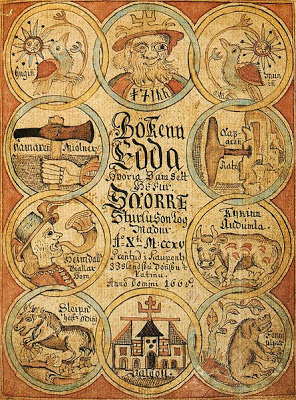
Snorri Sturluson: Prose Edda (1666)
Nobody knows if there was just one genius who originated the form, though it is true that Egil's Saga is sometimes attributed to the well-known historian Snorri Sturluson (1179–1241), author of Heimskringla and the - so-called - Prose Edda, a kind of encyclopedia of traditional Norse mythology and commentary on the very complicated ancient poems known as the Elder Edda. Besides that, however, no single author can be identified with any of the many surviving sagas, though internal evidence certainly suggests a number of different authors for the different stories.
It's also true to say that an exclusive focus on this particular type of saga falsifies the immense variety of prose literature available to medieval Icelandic readers.
Norse sagas are generally classified as:the Kings' sagas (Konungasögur),- Wikipedia: Entry on "Sagas"
Icelanders' sagas (Íslendinga sögur),
Short tales of Icelanders (Íslendingaþættir),
Contemporary sagas (Samtíðarsögur or Samtímasögur),
Legendary sagas (Fornaldarsögur),
Chivalric sagas (Riddarasögur),
Sagas of the Greenlanders (Grænlendingasögur),
Saints' sagas (Heilagra manna sögur)
and Bishops' sagas (Biskupa sögur).
Of all these genres, it's really only the Sagas of Icelanders and the Short Tales of Icelanders which are of central interest to contemporary readers. The first substantial critical treatment of any of them in English was written by Sir Walter Scott in the early nineteenth century, after he'd stumbled across an (abridged) Latin translation of Laxdæla saga. The culmination of all the vast amounts of scholarly attention they've received since then must surely be the five-volume edition of the complete corpus of family sagas (together with selected short tales) published in Iceland by the appropriately named "Leifur Eiriksson" [Leif Ericson] Publishing in 1997:
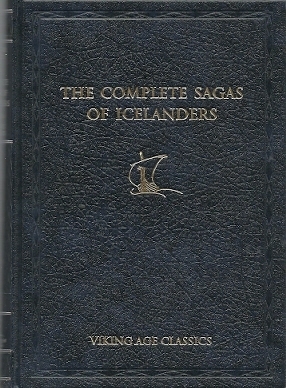
Vidar Hreinsson et al., ed.: The Complete Sagas of Icelanders (1997)
The Complete Sagas of Icelanders (including 49 Stories). General Editor: Viðar Hreinsson, Editorial Team: Robert Cook, Terry Gunnell, Keneva Kunz & Bernard Scudder. Introduction by Robert Kellogg. 5 vols. Viking Age Classics. Iceland: Leifur Eiriksson Publishing Ltd., 1997.Vinland / Warriors and PoetsForewordsBy the President of IcelandBy the Icelandic Minister of Education, Culture and ScienceBy the Former Director of the Manuscript Institute of IcelandPrefaceCreditsPublisher's AcknowledgmentsIntroductionVinland and GreenlandEirik the Red's SagaThe Saga of the GreenlandersWarriors and PoetsEgil's SagaKormak's SagaThe Saga of Hallfred the Troublesome PoetThe Saga of Bjorn, Champion of the Hitardal PeopleThe Saga of Gunnlaug Serpent-TongueTales of PoetsThe Tale of Arnor, the Poet of EarlsEinar Skulason's TaleThe Tale of Mani the PoetThe Tale of Ottar the BlackThe Tale of Sarcastic HalliStuf's TaleThe Tale of Thorarin Short-CloakThe Tale of Thorleif, the Earl's PoetAnecdotesThe Tale of Audun from the West FjordsThe Tale of Brand the GenerousHreidar's TaleThe Tale of the Story-Wise IcelanderIvar Ingimundarson's TaleThorarin Nefjolfsson's TaleThe Tale of Thorstein from the East FjordsThe Tale of Thorstein the CuriousThe Tale of Thorstein ShiverThe Tale of Thorvard Crow's-Beak
Outlaws / Warriors and PoetsOutlaws and Nature SpiritsGisli Sursson's SagaThe Saga of Grettir the StrongThe Saga of Hord and the People of HolmBard's SagaWarriors and PoetsKiller-Glum's SagaThe Tale of Ogmund BashThe Tale of Thorvald TasaldiThe Saga of the Sworn BrothersThormod's TaleThe Tale of Thorarin the OverbearingViglund's SagaTales of the SupernaturalThe Tale of the Cairn-DwellerThe Tale of the Mountain-DwellerStar-Oddi's DreamThe Tale of Thidrandi and ThorhallThe Tale of Thorhall Knapp
Epic / Champions and RoguesAn EpicNjal's SagaChampions and RoguesThe Saga of Finnbogi the MightyThe Saga of the People of FloiThe Saga of the People of KjalarnesJokul Buason's TaleGold-Thorir's SagaThe Saga of Thord MenaceThe Saga of Ref the SlyThe Saga of Gunnar, the Fool of KeldugnupTales of Champions and AdventuresGisl Illugason's TaleThe Tale of Gold-Asa's ThordHrafn Gudrunarson's TaleOrm Storolfsson's TaleThorgrim Hallason's Tale
Regional FeudsRegional FeudsThe Saga of the People of VatnsdalThe Saga of the Slayings on the HeathValla-Ljot's SagaThe Saga of the People of SvarfadardalThe Saga of the People of LjosavatnThe Saga of the People of Reykjadal and of Killer-SkutaThe Saga of Thorstein the WhiteThe Saga of the People of VopnafjordThe Tale of Thorstein Staff-StruckThe Tale of Thorstein Bull's LegThe Saga of Droplaug's SonsThe Saga of the People of FljotsdalThe Tale of Gunnar, the Slayer of ThidrandiBrandkrossi's TaleThorstein Sidu-Hallsson's SagaThorstein Sidu-Hallsson's TaleThorstein Sidu-Hallsson's DreamEgil Sidu-Hallsson's Tale
Epic / Wealth and PowerAn EpicThe Saga of the People of LaxardalBolli Bollason's TaleWealth and PowerThe Saga of the People of EyriThe Tale of Halldor Snorrason IThe Tale of Halldor Snorrason IIOlkofri's SagaHen-Thorir's SagaThe Saga of Hrafnkel Frey's GodiThe Saga of the ConfederatesOdd Ofeigsson's TaleThe Saga of Havard of IsafjordReligion and Conflict in Iceland and GreenlandThe Tale of Hromund the LameThe Tale of Svadi and Arnor Crone's-NoseThe Tale of Thorvald the Far-TravelledThe Tale of Thorsein Tent-PitcherThe Tale of the GreenlandersReference SectionMaps and TablesIllustrations and DiagramsGlossaryCross-Reference Index of CharactersContents of Volumes I-V
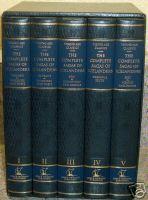
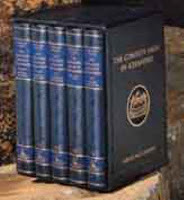
Since I'm pleased to say that I recently acquired a copy of this rather sumptuous tome, it seems useful to list its contents in this comprehensive manner as a way of signalling the wealth of material available to the saga aficionado. As well as the 45 sagas included in this collection, the editors have also inserted 49 short tales of Icelanders (marked off with italics in the table of contents above).
There are, of course, a great many other translations of individual sagas, some probably superior in literary merit to the somewhat bland and standardised version included in this complete edition (like modern editions of the Bible translated by committee).
The immense care taken by the editors of the "Leif Ericson" text to ensure consistency in vocabulary and (especially) names of people and places, makes it an indispensable resource for the scholar. If you don't want to invest in the complete edition, though, Penguin books have published some volumes of selections from the larger corpus:
The Sagas of Icelanders: A Selection. From The Complete Sagas of Icelanders (including 49 Stories). Ed. Viðar Hreinsson, Robert Cook, Terry Gunnell, Keneva Kunz & Bernard Scudder. Iceland: Leifur Eiriksson Publishing Ltd., 1997. Preface by Jane Smiley. Introduction by Robert Kellogg. Harmondsworth: Penguin, 2001.
Cook, Robert, trans. Njal’s Saga. From The Complete Sagas of Icelanders (including 49 Stories). Ed. Viðar Hreinsson, Robert Cook, Terry Gunnell, Keneva Kunz & Bernard Scudder. 1997. Penguin Classics. Harmondsworth: Penguin, 2001.
Whaley, Diana, ed. Sagas of Warrior-Poets. From The Complete Sagas of Icelanders (including 49 Stories). Ed. Viðar Hreinsson, Robert Cook, Terry Gunnell, Keneva Kunz & Bernard Scudder. 1997. Penguin Classics. Harmondsworth: Penguin, 2002.
The first of these is particularly good, with a fascinating preface by American novelist Jane Smiley, author of The Greenlanders (1988). It probably contains sufficient detail for most general readers, in fact, especially when combined with the separate translation Of Njal's Saga, by common consent the most individually "epic" of the Norse sagas, issued concurrently by Penguin Classics.
For any of you interested in pursuing the subject, though, I've listed below all of the other books on the subject I've collected since I first took a class in Old Norse with Professor Forrest Scott some thirty years ago in (I think) 1983:
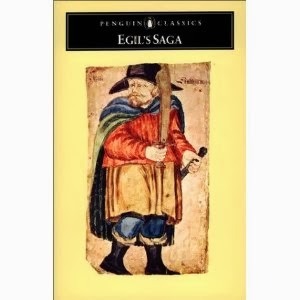
Egil's Saga
The Elder EddaSagasSnorri Sturluson (1179–1241)
The Elder Edda
Hollander, Lee M., trans. The Poetic Edda. 1962. Rev. ed. Austin: University of Texas Press, 2006.
Larrington, Carolyne, trans. The Poetic Edda. Oxford World's Classics. Oxford: Oxford University Press, 1996.
Magnúson, Eiríkr, & William Morris, trans. Volsunga Saga: The Story of the Volsungs and Niblungs, with Certain Songs from the Elder Edda. 1870. Ed. H. Halliday Sparling. The Camelot Series. Ed. Ernest Rhys. London: Walter Scott, 1888.
Morris, William, trans. Volsunga Saga: The Story of the Volsungs and Niblungs. 1870. Ed. Robert W. Gutman. 1962. New York & London: Collier & Collier-Macmillan, 1971.
Terry, Patricia, trans. Poems of the Vikings: The Elder Edda. Introduction by Charles Wisden. 1969. Indianapolis: Bobbs-Merrill Educational Publishing, 1981.
Sagas
Blake, N. F. ed. The Saga of the Jomsvikings: Jómsvíkinga Saga. Nelson’s Icelandic texts, ed. Sigurður Nordal & G. Turville-Petre. London: Nelson, 1962.
Dasent, George. M., trans. The Saga of Burnt Njal: From the Icelandic of Njal’s Saga. Everyman’s Library. London & New York: J. M. Dent & E. P. Dutton, n.d.
Hight, George Ainslie, trans. The Saga of Grettir the Strong: A Story of the Eleventh Century. Everyman’s Library 699. 1914. London & New York: J. M. Dent & E. P. Dutton, 1929.
Johnston, George, trans. The Saga of Gisli. Ed. Peter Foote. 1963. Everyman’s Library. London: Dent, 1984.
Jones, Gwyn, trans. Eirik the Red and other Icelandic Sagas. The World’s Classics. Oxford: Oxford University Pres, 1980.
Pálsson, Hermann, & Magnus Magnusson, trans. The Vinland Sagas: The Norse Discovery of America – Grænlendinga Saga & Eirik’s Saga. 1965. Penguin Classics. Harmondsworth: Penguin, 1971.
Pálsson, Hermann, & Magnus Magnusson, trans. King Harald’s Saga: Harald Hardradi of Norway – from Snorri Sturluson’s Heimskringla. 1966. Penguin Classics. Harmondsworth: Penguin, 1971.
Pálsson, Hermann, & Magnus Magnusson, trans. Laxdaela Saga. 1969. Penguin Classics. Harmondsworth: Penguin, 1976.
Pálsson, Hermann, trans. Hrafnkel’s Saga and Other Stories. 1971. Penguin Classics. Harmondsworth: Penguin, 1972.
Pálsson, Hermann, & Paul Edwards, trans. Hrolf Gautrekkson: A Viking Romance. New Saga Library 1. Edinburgh: Southgate, 1972.
Pálsson, Hermann, & Paul Edwards, trans. Eyrbyggja Saga. New Saga Library 2. Edinburgh: Southgate, 1973.
Pálsson, Hermann, & Paul Edwards, trans. Egil’s Saga. Penguin Classics. Harmondsworth: Penguin, 1976.
Pálsson, Hermann, & Paul Edwards, trans. Orkneyinga Saga: The History of the Earls of Orkney. 1978. Penguin Classics. Harmondsworth: Penguin, 1982.
Pálsson, Hermann, & Paul Edwards, trans. Seven Viking Romances. Penguin Classics. Harmondsworth: Penguin, 1985.
Snorri Sturluson (1179–1241)
Sturluson, Snorri. Edda. Trans. Anthony Faulkes. Everyman’s Library. London: Dent, 1987.
Sturlason, Snorre. Heimskringla: The Olaf Sagas. Trans. Samuel Laing. Ed. John Beveridge. Everyman’s Library 717. London & New York: J. M. Dent & E. P. Dutton, 1930.
Sturlason, Snorre. Heimskringla: The Norse King Sagas. Trans. Samuel Laing. Ed. John Beveridge. Everyman’s Library 847. London & New York: J. M. Dent & E. P. Dutton, 1930.
Sturlason, Snorre. Heimskringla, or The Lives of the Norse Kings. Trans. A. H. Smith & Erling Monsen. Ed. Erling Monsen. 1932. New York: Dover Publications, Inc., 1990.
You'll notice that a great many of the saga translations listed above were done by Hermann Pálsson of Edinburgh university, initially in collaboration with ex-UK Mastermind host (and proud Icelander) Magnus Magnusson, and subsequently with my old English Department mentor Paul Edwards. Edwards was a very amusing character, who used to hold court around a huge wooden table with flagons of wine and lively conversation for any passing colleagues or students. I benefited greatly from his encouragement and example, and it's nice to be able to commemorate him here (he died sometime in the early 1990s, I believe).
But after all this bibliographical preamble, what are the sagas actually like to read? Well, they're very deadpan, pithy, understated. A few quotes may give you the idea:
In chapter 45 of Grettis saga, Þorbjörn knocked loudly on the door at Atli's farm, then hid. When Atli went to the door, Þorbjörn rushed up holding his spear in two hands and ran Atli through. When he took the blow, Atli said, "Broad spears are in fashion these days," and fell dead.
Ha, ha - very witty! Or the off-the-cuff remark by one of the characters in Njal's saga that the health of the thralls is poor that season, after a bunch of them have been murdered by his neighbour. Or the comment by the anti-heroine Guðrún in Laxdæla saga about her behaviour throughout to the hero Kjartan:
Þá mælti Guðrún: "Þeim var eg verst er eg unni mest."
Auden translated her answer as "He that I loved the / Best, to him I was worst" in his poem "Journey to Iceland." His friend Christopher Isherwood had once remarked that the characters in the sagas reminded him a lot of the personnel at their public school, and that thought appears to be the inspiration behind a lot of Auden's early poetry, as well as - in particular - his strange revenge drama "Paid on Both Sides" (1928).
Sagas tend to be composed in short chapters, and to begin with elaborate genealogies of the (eventual) main characters - hence the designation "family sagas." If you skip over these lists of ancestors, you'll often miss the reason for a murder, or a lawsuit, or an act of revenge two hundred or so pages later. The saga authors never discuss their characters' motivations, or delve into their psychology. All the action is described with the utmost objectivity, in a kind of super-hardbitten prose with no room for fluff or sentiment.
The characters do often compose (or inspire) poems, which are frequently quoted in context, but the technical demands of Old Norse skaldic verse are so exigent, that this generally gives little clue to their "inner feelings" or softer side. On the contrary, in fact.
The fascination of the stories lies in the difficulty of understanding just why their protagonists behave as they do. The impossible and self-destructive perversity of many of their deeds is such as to seem virtually incomprehensible without the elaborate framework of family relationships and overarching doom-laden pessimism which seem to have distinguished medieval Icelanders even from other Vikings.
For a long time the sagas were assumed to be basically factual, with a few historical inconsistencies here and there caused by oral transmission. More modern research has demonstrated how carefully composed and crafted most of them are, however, and - in particular - how little reliability there is in their accounts of people and places (within a larger framework of agreed-upon knowledge provided by such texts as Landnámabók and Íslendingabók). In short, they resemble contemporary historical novels far more than the family memoirs or local histories they were once thought to be.
Are they "novels"? Not in the traditional sense of the term. They demand far more from the reader than most modern novels can afford to. A lazy reader will understand little of what goes on in even the great set-piece sagas such as Njal's Saga or Laxdaela Saga, let alone the more diffuse and thematically mixed sagas such as Eyrbyggja Saga. The matchless precision with which the great scenes and personalities within them are recreated on the page does,however, make them every bit as compelling for the dedicated reader as, say, Homer or Virgil, and it would be hard to see the whole corpus of saga literature as inferior even to that created by such "epic" novelists as Tolstoy or Faulkner.
As what we understand by a "novel" continues to expand and diversify, it becomes clearer and clearer that the Icelandic sagas, one of the most impressive bodies of prose fiction in existence, still have a lot more to teach contemporary writers than we've so far been willing to learn.
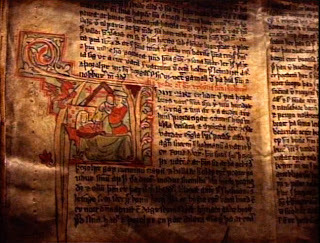
Íslendingasögur (13th century)
Published on December 17, 2013 13:53
December 11, 2013
1913
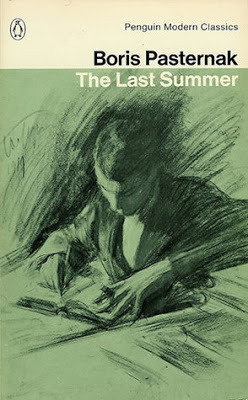
Boris Pasternak: The Last Summer (1934)
Boris Leonidovich Pasternak (1890-1960)
Pasternak, Boris. The Last Summer. 1934. Trans. George Reavey. 1959. Introduction by Lydia Slater. 1960. Harmondsworth: Penguin, 1961.
I suppose that the most famous evocation of the last summer before the First World War is this beautiful lyrical novella by Russian poet Boris Pasternak:
from the blurb:
... during the winter of 1916, Serezha visits his married sister. Tired after a long journey, he falls into a restless sleep and half-remembers, half-dreams the incidents of the last summer of peace before the First World War 'when life appeared to pay heed to individuals'. As tutor in a wealthy, unsettled Moscow household he focuses his intense romanticism on Mrs Arild, his employer's paid companion, while spending his nights with the prostitute Sashka.
I remember it was one of the very few pieces of fiction I've ever finished reading and then immediately restarted from the beginning. I felt I'd missed too much of the implications of what was going on in my blind pursuit of the story. And, much though I admire Doctor Zhivago, I have to say that I enjoyed The Last Summer, short though it is, far more.
As I was paging through all my old files of reviews for my new Opinions website (now substantially complete), I came across quite a few unpublished ones. In most cases this was only too explicable, but there did seem to be one or two which I thought might be worth resurrecting. You decide. One of them was of Robert Musil's famous much-referred-to-and-little-read novel The Man Without Qualities, which I must have been slogging my way through in late 1998.
Robert Mathias Edler von Musil (1880-1942)
Musil, Robert. Young Törless. 1906. Trans. Eithne Wilkins & Ernst Kaiser. 1955. Harmondsworth: Penguin, 1962.
Musil, Robert. Tonka and Other Stories. Trans. Eithne Wilkins & Ernst Kaiser. London: Secker & Warburg, 1965.
Musil, Robert. The Man Without Qualities. Vol. 1: A Sort of Introduction; The Like of It Now Happens (I). 1930. 3 vols. Trans. Eithne Wilkins & Ernst Kaiser. 1954. London: Picador, 1979.
Musil, Robert. The Man Without Qualities. Vol. 2: The Like of It Now Happens (II). 1930. 3 vols. Trans. Eithne Wilkins & Ernst Kaiser. 1954. London: Picador, 1979.
Musil, Robert. The Man Without Qualities. Vol. 3: Into the Millennium (The Criminals). 1932. 3 vols. Trans. Eithne Wilkins & Ernst Kaiser. 1954. London: Picador, 1979.
Musil, Robert. The Man Without Qualities: A Sort of Introduction; Pseudoreality Prevails; Into the Millennium. Trans. Sophie Wilkins and Burton Pike. 1995. London: Picador, 1997.
The reason it seems particularly significant to me now is that the whole immense novel is set in the year 1913, and one of the hero's main preoccupations throughout are the demands of a committee he belongs to whose job is to think of an appropriate way of commemorating the seventieth anniversary of the Emperor Franz Josef's accession to the throne of Austria-Hungary. When last heard of, the committee has settled on a suitable slogan for their celebrations: "Emperor of Peace" is to be the central motif.
I guess that none of you need me to tell you that by the year 1918, not only was stupid old Franz Josef safely dead and gone, but his entire empire and all it stood for was in ruins, and that any association between him and "peace" was somewhat belied by the frequent and brutal wars of repression he'd indulged in throughout his reign, from 1848 onwards ... There is something rather grand about the uselessness of it all, though: that committee solemnly deliberating as the clock ticks inexorably towards August, 1914.
I suppose that there's going to be no shortage of reminders of World War One over the next few years, as each ghastly anniversary of death and waste is reached, but I just couldn't resist reprinting my cheeky remarks about Musil's masterpiece here, just as I wrote them 15-odd years ago:
Robert Musil: The Man Without Qualities (1930-43)Robert Musil. The Man Without Qualities. Translated from the German by Sophie Wilkins; Editorial consultant Burton Pike. 1995. London: Picador, 1997.
Robert Musil: The Man Without Qualities (vol. 1)
Talking of blurbs, this one informs us that:The Man Without Qualities is one of the towering achievements of the European novel, and this edition is one of the most important publishing events of recent years.Well, you can’t say better than that. It goes on to trumpet:the fully-fleshed arrival in English of the third member of the trinity in twentieth-century fiction, complementing Ulysses and The Remembrance of Things Past …Fuck, better get reading, guys. Only, hang on a second – haven’t copies of The Man Without Qualities been thronging the shelves of second-hand bookshops for years, admittedly in three volumes rather than this one, imposing tome? (As Mad magazine once said: “In better stores in most cities; in lousier stores in all cities.”) Yes, but those were copies of the old translation, done from the old German edition. This is the new translation, done from the new (1978) German edition: Der Mann ohne Eigenschaften: Neu Edition, to be precise – not to be confused with the 1952 revised edition, or the 1930-43 first edition.
Robert Musil: The Man Without Qualities (vol. 2)
What’s more, not only does this version have a funky new New York translator, it also has an “editorial consultant” (Is it his job to make the coffee? Or does he just sit in his office and wait to be consulted?) Enough of these cheap shots, though. You’ll be beginning to suspect that I haven’t read it through.
No, I have read the damned thing from cover to cover – call it my holiday project. I mean, I’ve heard that one before about novels on a par with Joyce’s Ulysses and Proust’s À la recherche du temps perdu – last time it was Andrei Bely’s Petersburg, from no less a person than Vladimir Nabokov. And it wasn’t true then either.
Musil’s master-work begins well enough. The first chapter of Part One: “A Sort of Introduction,” is entitled “From Which, Remarkably Enough, Nothing Develops,” and sure enough, nothing does. We are introduced to our hero, Ulrich, who has no qualities to speak of, but whose career bears a certain resemblance to that of his creator, Robert Musil. Both began as soldiers. Both quit: Ulrich to become a mathematician, Musil to become an engineer. Musil, however, wrote a bestselling novel, Young Törless, when he was only twenty-six, and subsequently fought with distinction in the First World War. Ulrich is caught forever in a kind of sabbatical from life. It is 1913, just before the balloon went up.
And what does he do with his time? Well, he has a mistress (this is Vienna, after all), and he is interested in a sex criminal called Moosbrugger, whom he sees as an alter-ego, and he has a variety of neurotic and over-educated friends. Most of it, though, he spends on a committee he’s been roped into, which is supposed to be thinking of an appropriate way of celebrating the Emperor Franz Josef’s 70th jubilee in 1918. “Emperor of Peace,” as they like to call him.
Yep, there could be something a mite symbolic there, I reckon. I mean, is this Franz Josef character ever going to reach the year 1918, I keep asking myself? I can’t tell you how many hundreds of pages are spent describing the committee’s deliberations (at least half the book – and it’s 1130 pages long. “That’s a big twinkie,” as the man said in Ghostbusters.)
Part Three: “Into the Millennium” (or “The Criminals”) starts off promisingly, on page 726. Even Musil seems to have had enough of the committee for the moment, so he bumps off Ulrich’s father and introduces a rather saucy sister, Agathe, whom we haven’t met before. And it turns out Ulrich hasn’t seen her for years either, and finds her … strangely fascinating. By page 936, after a few hot glances over a wooden table on a mountain walk, “it would have been as untrue to say that she was disinclined to enter into illicit relations with her brother as that she desired to.” Instead, Ulrich goes back to Vienna to lecture his mistress on polyglandular balance, but it’s not long (a mere forty pages) before Agathe comes to join him. You’d think after all that they might actually do it, but Ulrich’s far more interested in talking. And he was still talking a hundred and fifty pages later when the pen dropped from Musil’s stiff, dead fingers. The last words of the novel are:It was only then that Ulrich learned that Agathe had suddenly said good-bye and left the house without him. She had left word that she had not wanted to disturb him.No, I mean: “Emperor of peace.” That sort of shit is important, man.
There’s something rather sad about it, in retrospect. It must have seemed such a cool idea: Vienna on the verge of the First World War, the pseudorealities of the past contrasted with dawning modernity – a drifting, futile, intellectual simultaneously disenchanted and fascinated by the intricacies of a dying civilisation … Jeremy Irons for Ulrich?
And the beginning is pretty sharp. But the years went by, the Weimar republic fell, Hitler came to power – all of a sudden a novel about committee politics in 1913 began to look a bit out of touch. Musil halfheartedly introduced a few ethnic German ideologues halfway through as a contribution to world peace.
And the point? Well, of course the futile committee planning a jubilee for 1918 can be seen as a model for Musil’s own novel: an enterprise wildly overtaken by events, “modern” by the standards of fin-de-siècle Vienna, but surviving into the world of Finnegans Wake. It was never finished. It seems impossible that it ever could have been finished. The time for that was long past: about 1922, perhaps, when it would have made a nice companion piece to Thomas Mann’s Magic Mountain.
The terrible thing is that Musil could still have saved it all, if only he could have stopped his hero prosing on, pompously, interminably, as Rachel the maid slips off to sleep with Solomon, and frigid Clarisse gets madder and madder, and Moosbrugger languishes in his cell, and dear Agathe is driven, finally, to get religion rather than listen to any more.
A terrible warning to us all? You think so? Buy it. You won’t regret it. Trust me.
[Unpublished (c.1998)]
I can't promise that I won't put up further posts as we reach some of those other milestones on the road to the Armageddon of 1914-18. I'll try to be a bit more respectful next time, though, perhaps. Or maybe not ...
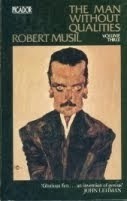
Robert Musil: The Man Without Qualities (vol. 3)
Published on December 11, 2013 15:29
December 4, 2013
A Triptych for Lee Dowrick
i.m. Lee Dowrick (b. 1931 - d. 29/11/13)
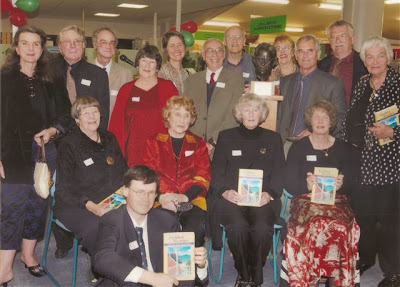
Launch of Golden Weather Anthology in Takapuna Library (19 September, 2004)
[Back Row (l-to-r): Shonagh Koea / Alistair Paterson / Stu Bagby / Lee Dowrick / Jan Kemp / Tony Green / C. K. Stead / Bust of Frank Sargeson / Wensley Willcox / Graeme Lay / Kevin Ireland
Front Row (l-to-r): Christine Cole Catley / Jack Ross / Jean Bartlett / Alice Hooton / Jacqueline Crompton Ottaway / Riemke Ensing]
It's Lee Dowrick's funeral today. For roughly a decade a group of us used to meet every month at her house in Devonport to read out poems and trade gossip about the "literary life." I have to say that I owe her quite a debt. That note she left in the Baxter and Mansfield Second-hand Bookshop, inviting aspiring poets to join her little group of "bookshop poets," made a big difference to me.
I met such poets as Leicester Kyle, Stu Bagby, and Raewyn Alexander through Lee's good graces. The other core members of the group, Alice Hooton, Jackie Ottaway, Wensley Willcox, became good friends and valued collaborators over the years. That invitation of Lee's, and her unfailing hospitality, helped to get me out of my solipsistic cave and out meeting other writers instead. My very first book launch, in 1998, was together with one of Lee's: That Was Then.
Today I'm going to her funeral, in Devonport, down by the sea, the little suburb she loved. Funny the way things turn out. The first time we met, it turned out that she'd once been a patient of my father's (as an East Coast Bays GP, there seem to have been few people here who didn't visit his surgery at one time or another). The last time we met, in the shopping centre, a couple of years ago now, she didn't know who I was, and couldn't think how to respond to my cheerful "Hi, Lee!"
I don't have much more to say about Lee, other than to say what a careful crafter of words she was, and that the few books of mostly nostalgiac poems she did publish don't really do justice to her gift as a writer. To demonstrate that, I thought I'd include a few of her poems here, ones which I published myself during my stint as co-editor of Spin. What better memorial for a poet than a few of the many, many poems she wrote and published over the years?:
happily never after
we’ll be married
in your protestant church
no room at the altar in mine
my family won’t come
our children will be
out of wedlock
don’t drink
from the beer bottle
please my darling
not while
you’re
at the wheel
- Spin 36 (2000): 23.
sugarloaf
he shuffles along
feet heavy to lift
weighed down
with Oxford labels
vacating the brain
they slide down
the stalwart column
of his spine
to sit squarely
in laced up shoes
the wonderment
of this sweet life
- Spin 42 (2002): 22.
not waiting for mummy
I attack
the grimy comers of my roomwhile I wait
I scour them down
dig out
the stubborn stuff
black
built up layers
a sharp knife
shaves the skinagain
I scrape the corners
I haven’t
reached the pink yet
thick-skinned
I waitsoon
I will pick up
the silent beast
and dial a holiday
in Egypt
- Spin 33 (1999): 26.
Goodbye, Lee. We're all going to miss you a lot.
•
Published on December 04, 2013 12:35

